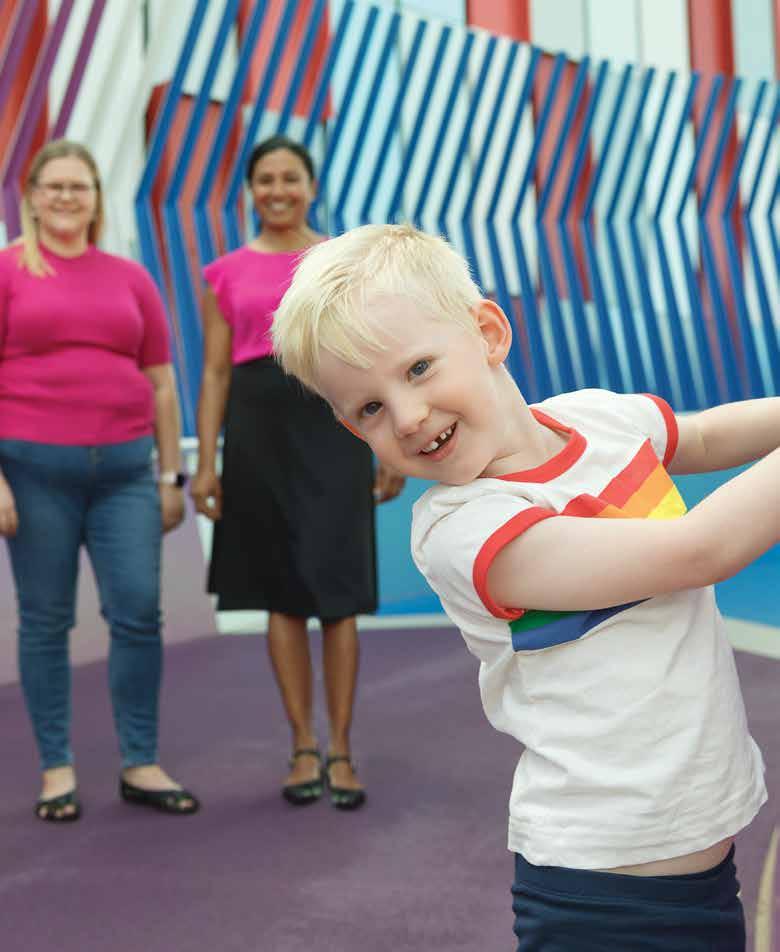

2023
REPORT
INTRODUCTION
4 FOREWORD
6 2022 AT A GLANCE
TRANSLATION
THIS RESEARCH HAS BEEN ACTIVELY TRANSLATED INTO POLICY OR PRACTICE
10 DCD a heavy burden for little Toby
13 ‘We can’t unknow what we’ve learned about Banksia Hill’
14 New roadmap to help families navigate support for autistic children
16 Tate is in good hands at CliniKids
18 Malaria control a global effort
19 New pneumococcal vaccine closes in on approval
20 Website for parents of trans youth to save lives
22 Nourish resources good for the body and the soul
PARADIGM SHIFT
THIS RESEARCH CHANGES THE VERY WAY WE THINK
26 Breakthrough antibiotic discovery opens Pandora’s Box
28 Giving kids with CF a chance at a longer, healthier life
30 Helping our smallest babies live their biggest lives
33 Biodiesels not as clean and green as they seem
COLLABORATING FOR IMPACT
THIS RESEARCH SHOWS HOW WE WORK WITH OTHERS TO MAKE A DIFERENCE
37 Deadly bug in researchers’ sight at Telethon Kids
38 SToP-ping skins sores in the Kimberley
39 Unlocking the benefit of genomics for Indigenous Australians
40 Study enables research projects
42 Worrying findings lead to new project to help fathers flourish
44 Perth dogs helping to fight cancer
45 New treatments on horizon for rarest child brain cancers
47 Campaign designed to improve the lung health of Aboriginal children
IN THE PIPELINE
THIS RESEARCH IS IN THE PIPELINE TOWARDS TRANSLATION
50 Early detection helps delay onset of diabetes
52 Healing airways so kids with asthma can breathe better
54 New life breathed into ground-breaking Aboriginal child health survey
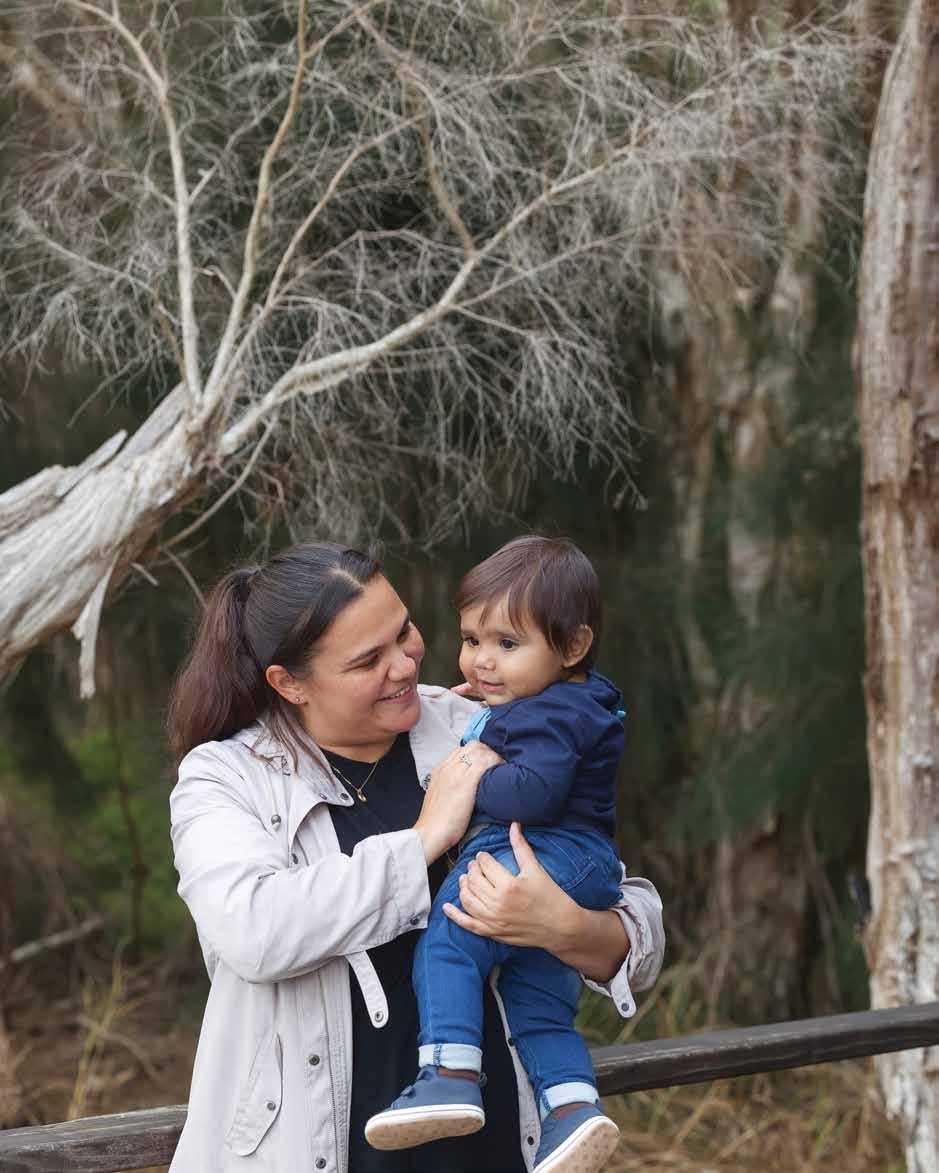
56 Journey Together for a better future for Aboriginal Kids
58 Pre-surgery fasting tablet helping to keep kids comfortable
60 Researchers call for rethink on infant screentime
Our special thanks to those who have contributed to this report including the researchers and families whose stories we have shared.
IMPACT REPORT 2023 | 3
Telethon Kids Institute acknowledges Aboriginal and Torres Strait Islander people as the Traditional Custodians of the land and waters of Australia. We also acknowledge the Nyoongar Wadjuk, Yawuru, Kariyarra and Kaurna Elders, their people and their land upon which the Institute is located and seek their wisdom in our work to improve the health and development of all children.
Cover photo: Alex Chatteron, 4, is doing his bit to help find a cure for type 1 diabetes – p51.
Left: Kellie Austin with her one-year-old son Graham.
FOREWORD
In its simplest form, science is about asking questions and finding answers. But it’s what we do with those answers that truly makes a difference.
At Telethon Kids Institute, it isn’t enough for us to do great science. We want our research to have impact - to be useful and used - so that we can change the lives of children and young people for the better, wherever they may be. And that means doing things differently.

Our 2023 Impact Report features some outstanding research projects which have come about because we’ve challenged the status quo, asked the hard questions, or thought outside the box. Some of these projects are just beginning, while others are already influencing public policy, but all of them have at their heart a commitment to translating our research into meaningful impact.
Several of these projects have looked at what we already know and do, and reimagined another way of achieving even greater outcomes. Our researchers have taken up the fight against antimicrobial resistance, reconsidered the advice on children’s screentime, established a standard-of-care protocol for the rarest of child brain cancers, and will be revisiting the data from the ambitious Western Australian Aboriginal Child Health Survey embarked on by the Institute in 1998 to pinpoint areas of focus to improve the health and wellbeing of Aboriginal communities.
Using innovation, cutting-edge technology and outside-the-box thinking, we’ve pushed new frontiers. In the labs, we’ve developed a pre-surgery fasting tablet for babies and very young children, undertaken a world-first treatment for sarcoma, with a clinical trial in dogs as a first step to treating children, and are investigating whether an approved pain medication will help heal the airways of kids with asthma. We’re establishing a national network which will advance genomic medicine for Aboriginal and Torres Strait Islander people.
You’ll also read in this report how we’ve contributed to some difficult conversations. Relying on our ground-breaking Banksia Hill research, we’ve used the evidence to educate and inform the discussions around youth detention in WA. And our worldleading research in biodiesel exhausts has already led to policy changes aimed at protecting the health and safety of Australian workers.
There are many examples of how our work is already helping families. Our research has contributed to the development of Australia’s first national guidelines for autism, helping families navigate the best clinical support for their autistic child. Together with Aboriginal communities, we’ve co-designed books, artwork and hiphop videos to promote healthy skin and prevent disease. We’ve created an online resource to help parents with life-changing decisions around gastrostomy, and identified ways to better support new fathers, to name just a few.
I am incredibly proud of the work we have done over the past year, and we couldn’t have done it without you. Our heartfelt thanks to everyone who supports our research in whatever way – as a study participant, a donor or funder, a collaborator, a service provider, or a community member.
These stories are just some of the 800 research projects we have underway at the Institute. I encourage you to find out more about our work and its impact by visiting telethonkids.org.au
IMPACT REPORT 2023 | 5
4
Professor Jonathan Carapetis AM
Left: Professor Carapetis with three-year-old Henley Candido.
2022 AT A GLANCE
Advancing knowledge
Measuring
1Citation refers to a quotation or reference of our work in a scientific article written by other researchers around the world. 2CNCI is an unbiased indicator of impact irrespective of age, subject focus or document type. It allows comparisons between entities of different sizes and subject mixes. A CNCI value of 1 represents performance at par with world average. A CNCI value of 2 is considered twice the world average. Source: Clarivate Incites.
Capacity building Developing our researchers and research infrastructure
Health, economic and social impacts Improving health outcomes
6 TELETHON KIDS INSTITUTE IMPACT REPORT 2023 | 7
our
and
Submitted 335 grant applications Awarded more than $60 million in research funding Researchers received 74% of the WA Child Health Research Fund funding pool We delivered 7 commissioned reports to government and non-government organisations Australia Number of organisations we colloborate and partner with around the world North America Asia South America Europe Africa New Zealand 103 118 20 22 612 12 5 Total publications in 2022 – 645 Publications with Telethon Kids researcher as first or senior author 54%
research quality, activity
outreach
(Hirsch
Total number of articles cited in 2022 31,0831 In 2022 108 of our articles had a CNCI greater than 22 29 researchers have a Scopus H-index greater than 403 Our researchers delivered 379 oral presentations We partner with 258 national and international organisations In 2022 we hosted 232 students Honours 41 Masters MD PhD 29 5 157 797 Staff Informing decision-making Helping to shape informed change to improve child health International 119 We provided our expertise to inform child health work on 155 occasions Our researchers are actively involved in 405 external decision-making groups to improve the lives of children and families National 154 Western Australia 132
3H-Index of 40 is proposed to characterise outstanding scientists likely to be found only at the top universities or major research laboratories
2005 PNAS) Source: Scopus
39 clinical trials and 85 non-clinical trials We developed 12 resources and services to help improve child health 3 Provisional Patents filed In 2022 we had 4 spinout companies 12 current active patents In 2022 we ran 12 Invention Disclosures lodged
TRANSLATION
THIS RESEARCH HAS BEEN ACTIVELY TRANSLATED INTO POLICY OR PRACTICE
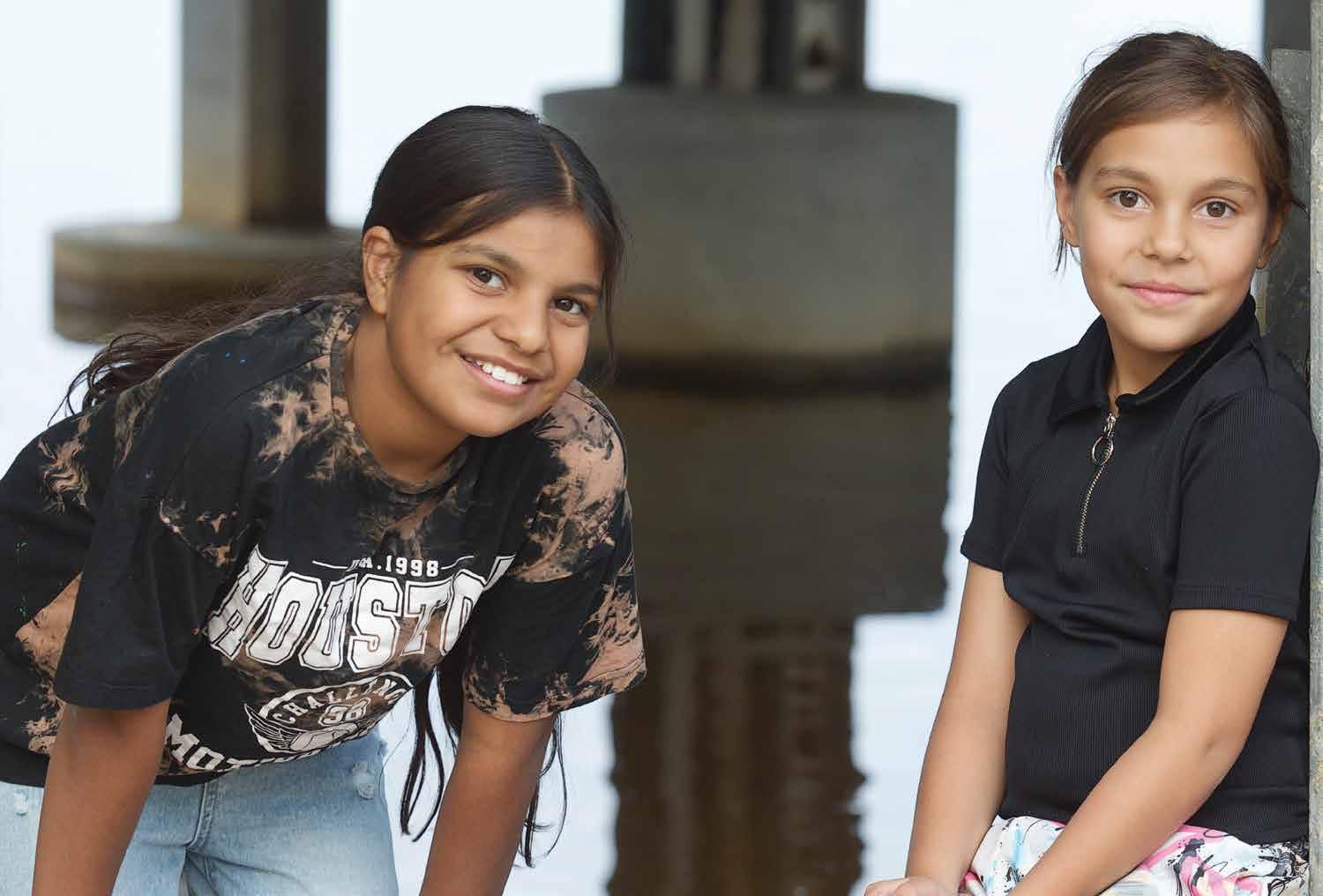
8 TELETHON KIDS INSTITUTE IMPACT REPORT 2023 | 9
Amara Austin, 10, (left) and Ruby Austin, 7
Slightly built and knee-high to a grasshopper, seven-year-old Toby doesn’t exactly look like a soldier doing double duty with a 50kg pack strapped to his back.
But with the extra effort he puts in every day just to walk, he may as well be that soldier.
“That’s how much harder he has to work and how much more fatigued he is after, say, walking around the school oval –something so simple for other kids,” Toby’s mum Caroline said.
“Even sitting up at school is exhausting for him – just trying to hold that posture while sitting on a chair.”
Toby has developmental coordination disorder (DCD), a neurodevelopmental condition that causes delays and impairments in fine and gross motor skills.
DCD affects most aspects of daily living that involve movement, including eating with utensils, drinking from a cup, getting dressed, walking and running, climbing and writing. Toby, who was diagnosed with DCD at the age of four, struggles with all the above.
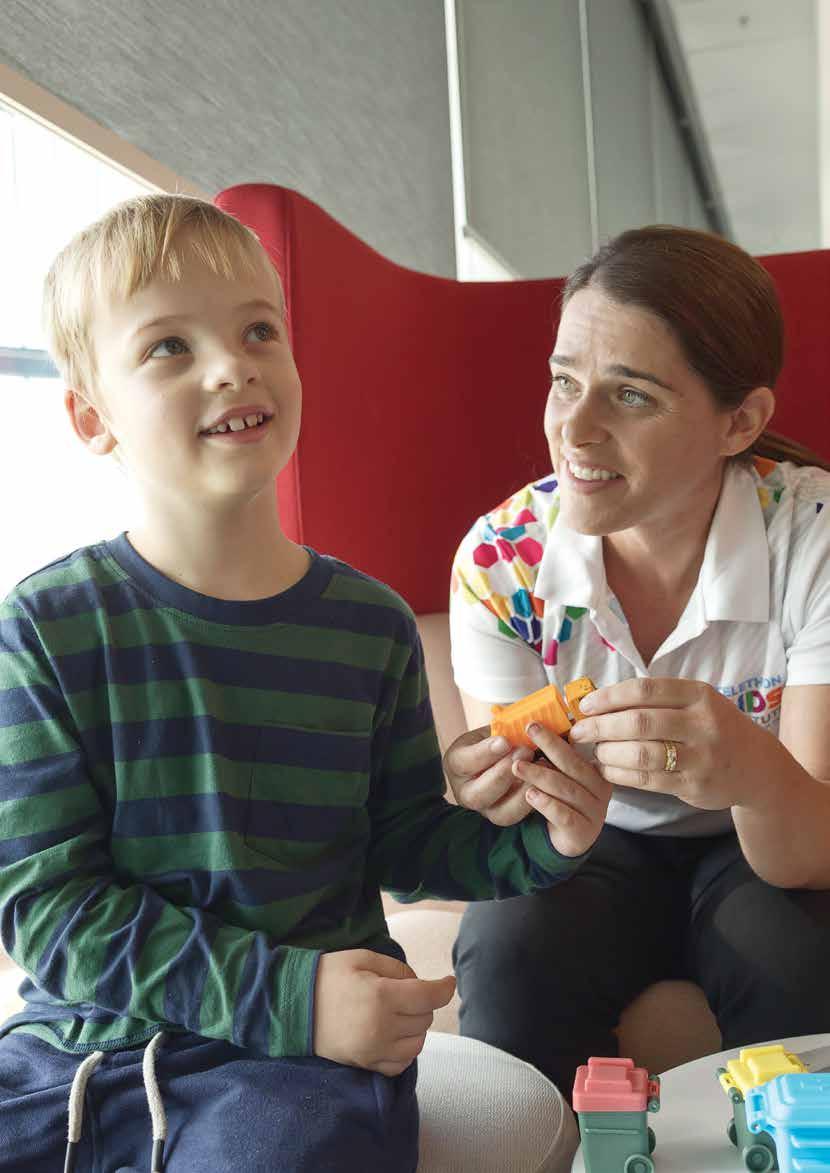
Big steps to better understanding developmental disorder
It’s more than 20 years since Dr Melissa Licari first began researching Developmental Coordination Disorder (DCD).
Sometimes referred to as dyspraxia, DCD is a lifelong neurodevelopmental condition which affects a child’s ability to learn and perform the basic motor skills needed for everyday activities.
Children with DCD are often assumed to be clumsy or lazy and can suffer low selfesteem or anxiety. While the disorder can occur in isolation, it’s common in children with autism and ADHD and children born preterm.
“So many of these kids struggle to keep up in the classroom and playground, and often experience bullying and exclusion by their peers,” Dr Licari said. “The impact on their lives can be profound.”
families experienced in getting a diagnosis and support and revealed there was still no consistent terminology or standardised practice for diagnosis of DCD in Australia. It found families were desperate for Australiaspecific resources to help them, educators and medical and allied professionals better identify, understand, and support DCD.
Dr Licari has since worked with families, teachers, clinicians and advocacy group DCD Australia to produce those resources – now freely available on DCD Australia’s new website. Shadow WA Early Childhood Education Minister Donna Faragher has taken up the cause, helping to advocate for the educator-focused resources to become available in WA schools.
Excitingly, the Impact for DCD model has been picked up internationally.
“His writing is completely illegible because he doesn’t have the coordination to hold his pencil, the strength to form letters or the stamina to keep writing,” Caroline said.
“He can read and he’s incredible with numbers, but actually putting it down in writing and demonstrating that knowledge is really hard.”
DCD is estimated to affect one child in every Australian classroom, yet remains poorly recognised among health professionals, teachers and education authorities.
Even Caroline, an early childhood teacher trained in special needs, had never heard of it before Toby’s diagnosis.
“I look back on so many children taught and think ‘That kid definitely had DCD’, yet they were just known as the clumsy kid who fell over when they walked or couldn’t catch the ball,” she said.
“I’d just really like to see more awareness in the community, especially among health professionals and schools.”
Toby with Dr Melissa Licari
Despite having been in diagnostic manuals since 1994 and the fact it affects around 5 per cent of Australian children, DCD is one of the most under-recognised neurodevelopmental disorders in Australia – partly thanks to a lack of evidence demonstrating its impact on children and families.
It’s a gap Dr Licari has been steadily filling through dogged, largely unfunded research and advocacy which in the past year has led to a website, comprehensive resources for families, teachers and health professionals, and an international research effort involving thousands of people with DCD across seven countries. Her findings also featured in a submission to the Disability Royal Commission.
Much of this progress has stemmed from Impact for DCD, a national report published by Dr Licari in 2020 on what was then the largest study worldwide aimed at identifying the challenges faced by children with DCD. The report, which presented data on more than 440 children, highlighted the difficulties
“What started as an idea here to raise awareness of DCD and have that first concrete evidence of the massive impact it is having on families, has been noticed by people around the world,” Dr Licari said.
After being contacted by researchers from Canada, the United States, the United Kingdom, Belgium, Finland, Sweden and Germany, Dr Licari shared her survey and helped the international teams modify it for their own contexts.
“They are now collecting their respective data and the plan is for them to release their own impact reports, which we’ll eventually pull together to see what we can learn from one another. With all the countries combined, so far we have more than 4,000 children involved – it’s huge.”
The model has also been expanded to other neurodevelopmental disorders experiencing similar awareness challenges as DCD, with Dr Licari currently working with the Tourette syndrome community to deliver Australia’s first national survey on Tourette’s and ticrelated conditions.
IMPACT REPORT 2023 | 11
10
DCD a heavy burden for little Toby
Banksia Hill Project to be replicated
Aotearoa (New Zealand) has embarked on its own version of the ground-breaking Banksia Hill study led by Telethon Kids Institute, expanding the project to include children in government care as well as those involved in the youth justice system.
Spurred by the Banksia Hill experience, the three-year, $1.4 million project will seek to establish FASD prevalence in the youth justice system and better understand the care needs of children living with FASD who are involved with the country’s Ministry for Children.
The research team will include Telethon Kids and Perth Children’s Hospital researcher and paediatrician, Clinical Associate Professor Raewyn Mutch – a Kāi Tahu First Nations scholar who was also a chief investigator on the Banksia Hill team. The project team will work with youth justice staff, FASD experts, carers, and Whānau (extended family) of young people diagnosed with FASD to codesign specialised services, clinical practice guidelines, and workforce training resources.
Did you know?
• Fetal Alcohol Spectrum Disorder (FASD) is a neurodevelopmental disorder caused when an unborn child is exposed to alcohol in the womb, which can lead to lifelong disability
• The Banksia Hill Project, led by a Telethon Kids Institute research team and published in 2018, was the first study in Australia to assess young people in a youth custodial setting for FASD
• The researchers found 36 per cent of the 100 young people assessed at WA’s only youth detention centre had FASD, while 89 per cent had at least one form of severe neurodevelopmental impairment – most of which had not been previously diagnosed
Telethon Kids Institute has been among a growing number of voices passionately advocating for an overhaul of the way young people in detention are managed in Western Australia.
The conversation has been far from easy, with tensions running high since the State Government decided in 2022 to move a group of young people from the embattled Banksia Hill Youth Detention Centre to a dedicated unit within adult prison Casuarina, following repeated outbreaks of violence and damage.
In July 2022 the Institute’s Executive Director, Professor Jonathan Carapetis, and Director of First Nations Strategy and Leadership Associate Professor Glenn Pearson, wrote to Premier Mark McGowan expressing deep disappointment and concern at the move and urgently calling on the Government to establish a Youth Justice Taskforce to address issues at Banksia Hill.

The intent was to work in partnership with Government behind the scenes to develop a short, medium and long term plan to develop solutions and avoid potentially catastrophic consequences for the children, families and the broader community.
They cited Telethon Kids’ ground-breaking research into the neurodevelopmental health of young people at Banksia Hill, undertaken as part of Australia’s first study to investigate the prevalence of Fetal Alcohol Spectrum Disorder among young people in a custodial setting.
The Banksia Hill Project found unprecedented levels of neurodevelopmental impairment in the 10–17-year-olds detained at Banksia Hill, with nine out of 10 having at least one form of severe developmental impairment; and
highlighted the difficulties experienced by them as a result.
Following a growing public outcry, Professor Carapetis was invited to attend a meeting called by the Premier with a range of representatives to discuss the situation at Banksia Hill. At the meeting, held in November 2022, the Institute reiterated its willingness to contribute to solutions, and emphasised that Aboriginal voices must be prioritised.
Associate Professor Pearson acknowledged that Banksia Hill was not an easy or popular topic to advocate on, but ethically and morally, the Institute had no choice but to speak up.
“There’s an inherent responsibility when we invite ourselves into the lives of people by way of our research, and that takes the shape of the work that we are now required to do in order to address all the things we now know, thanks to that research,” Associate Professor Pearson said.
“We’re not just researchers who take photos over a series of time and then do an analysis of the photos.
“We can’t unknow what we’ve learned through the Banksia Hill study about the circumstances of these children –the condition in which they arrive, the circumstances they’re being held in, the limited and frustrated abilities of the custodial staff to care for these kids.
“We’re not saying these kids shouldn’t have consequences in life. Aboriginal people have traditional law that manages every part of our lives for that reason. But we have to have more in the tank than what is happening right now.”
IMPACT REPORT 2023 | 13
‘We can’t unknow what we’ve learned about Banksia Hill’
12
Left: Associate Professor Glenn Pearson, Director of First Nations Strategy and Leadership at Telethon Kids Institute
New roadmap to help families navigate support for autistic children
Kids on the autism spectrum need to be embraced and any support provided to them should honour their childhood.
That is according to Australia’s first national guideline for supporting the learning, participation and wellbeing of autistic children and their families, which was developed by Autism CRC, the world’s first national, cooperative research effort focused on autism.
Autism CRC brought together a group of clinicians, researchers, and autistic adults to write the guideline, the development of which was co-led by Professor Andrew Whitehouse, Director of Clinikids and the Angela Wright Bennett Professor of Autism Research at Telethon Kids and The University of Western Australia; and Associate Professor David Trembath from Griffith University, Telethon Kids and Clinikids.
Professor Whitehouse, who is also the Research Strategy Director at Autism CRC, said the guideline represented a landmark
moment for autism in Australia and was the culmination of a decades-long effort to build better evidence into clinical practice for autistic children.
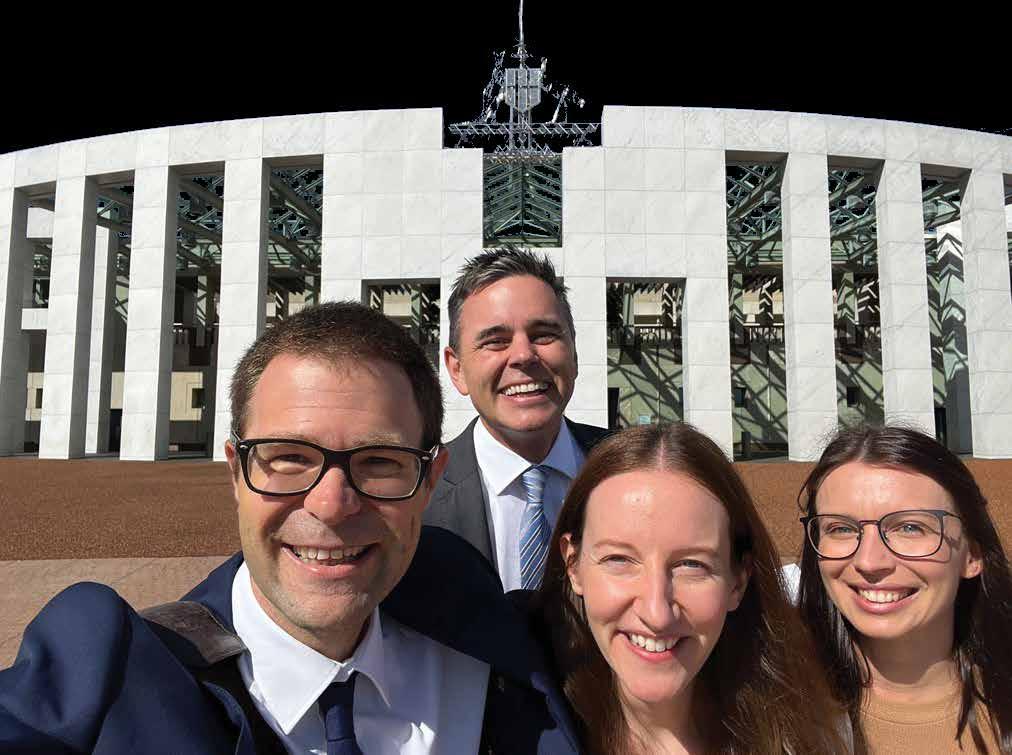
He said the guideline included 84 recommendations — all approved by the National Health and Medical Research Council — which outlined the best ways of providing clinical support to autistic children and their families.
Federal Minister for Social Services, the Hon Amanda Rishworth MP, launched the guideline in Canberra in February.
“For too long there’s been misinformation and a lack of evidence-based practice when it comes to autism therapies,” Professor Whitehouse said.
“Now, for the first time, families of children with autism will have a clear description of what is and what is not safe and effective clinical practice, and a roadmap to empower their choices.
Language key to autism inclusivity
“The guideline will help families understand what evidence-based therapy looks like, and how they can use this information to navigate the best pathway for their child.
“The recommendations provide a framework through which evidencebased practice can be implemented across Australia.”

CliniKids Research Development Manager Sarah Pillar, who helped write the guideline, said the document provided better guidance to clinicians about what represented good autism practice.
We know words matter and now new research looking at autism terminology has shone the spotlight on what autistic people want you to call them.
The research — a collaboration between Telethon Kids Institute’s CliniKids, the University of Auckland and Victoria University of Wellington — has called for an update to the language used to describe autism in studies, and more broadly, to reduce stigmatisation, marginalisation, and exclusion of autistic people.
The inclusive language guide was co-authored by autistic researcher Dr Ruth Monk, Professor Andrew Whitehouse and Hannah Waddington.
Professor Whitehouse, the Angela Wright Bennett Professor of Autism Research at Telethon Kids and The University of Western Australia and Director of CliniKids, said the past three decades had seen a major shift in our understanding of the strong links between autism and identity, prompting a need for careful consideration of the language used to describe autism.
“Historically, most autism research has been carried out without input from autistic people and this research has often described autism and autistic people using medicalised and deficit-based language such as disorder, impairment, and person-first language,” Professor Whitehouse said.
“Part of conveying all the amazing things and ways that we can support autistic children to become happy healthy adults is actually changing the way we talk about it.”
IN OUT
Next Steps
► While the guideline is not mandatory, it is hoped it will be endorsed and implemented by policymakers and peak clinical and consumer bodies, including the National Disability Insurance Scheme
► The guideline recommendations will be reviewed and updated on a regular basis to respond to new evidence from research, clinical practice, or changes in community preferences and priorities
Autism, autistic Autism Spectrum Disorder
Identity-first language ie autistic person
Person-first language eg person with autism
Autistic experiences and characteristics Autism symptoms and impairments
Increased likelihood of being autistic; may be autistic
At risk of autism
Specific support or service Cure, treatment or intervention
Allistic or non-autistic Normal person
The Guideline was developed by the Autism CRC and included researchers, clinicians and peak consumer bodies from Telethon Kids Institute, The University of Western Australia, Griffith University, Victoria University of Wellington, University of New South Wales, Positive Partnerships, University of Southern Queensland, Autism Queensland, La Trobe University, and the University of Sydney
IMPACT REPORT 2023 15
Below left: Professor Andrew Whitehouse, Associate Professor David Trembath, Sarah Pillar and Dr Rhylee Sulek in Canberra for the launch of the guideline
Professor Andrew Whitehouse is supported by the Angela Wright Bennett Foundation
Tate is in good hands at CliniKids
Tapping into the healing nature of water
In Aboriginal culture, water is life, holding powerful spiritual and cultural significance and acting as a vital source of connection, food and medicine.
It is this healing nature of water that now sits at the centre of a major program of research being led by researchers from Telethon Kids Institute and Curtin University.

A team headed by Associate Professor Anthony Kicic and Dr Angela Fuery is investigating how bacteriophage, or phage – naturally occurring viruses that infect and kill harmful bacteria – can help to overcome persistent infections that have become resistant to conventional antibiotics.
The novel approach could prove particularly transformational for Aboriginal communities, where skin, ear and lung infections – and antibiotic resistance – occur at higher rates than in the wider population.
Professor Kicic said part of that conversation might even be about how phages might be similar to Traditional treatments.
The researchers have already begun working with Noongar language teacher and Whadjuk Noongar woman Sharon Gregory to name phages sourced around the Perth area as part of the storytelling journey for the Noongar region. The project, where phage names are inspired by their appearance, has already seen one phage named ‘Kara-mokiny kep-wari Wadjak’ –translating to ‘spider-like stillwater pond from Wadjuk’.
“Looking at the pictures is how I put the Noongar words together, when I had wrapped my head around what a phage was,” Ms Gregory said.
Tate Roberts was aged three when he was diagnosed with autism in 2022.
At the time, Tate’s family was well accustomed to receiving support for his DiGeorge Syndrome, a genetic condition that was picked up through Telethon Kids Institute’s ORIGINS Project at his one-year-old assessment.
DiGeorge Syndrome is caused when a small part of chromosome 22 is missing and can lead to congenital heart problems, developmental delays and learning challenges. Tate also has Neurofibromatosis 1 (NF1), a condition characterised by changes in skin pigmentation.
Tate, who turns four in September 2023, currently receives support to help him achieve his goals, including occupational therapy and speech pathology at CliniKids’ new Joondalup clinic.

His father, Mark Roberts, said the family had been engaged with CliniKids for about a year, after the service came highly recommended by a speech pathologist Tate had seen previously.
“We have 100 per cent trust in CliniKids, It’s comforting knowing that Tate is receiving the best evidence-based therapies available,” Mr Roberts said.
“The supports he is receiving do seem to be helping with his coordination, and his interaction and communication with us.
“His therapists go above and beyond to ensure everyone, including his NDIS coordinator and daycare support worker, are all on the same page with Tate’s support. They are brilliant.”
Given its potential significance to Aboriginal communities, the Phage WA team within the Wal-yan Respiratory Research Centre – a powerhouse partnership between Telethon Kids Institute, Perth Children’s Hospital Foundation and Perth Children’s Hospital – has begun consulting with Elders in communities across the State to ensure local voices are involved at every step.
“Instead of just walking in with phage in a bottle, we’ve developed a process of engagement, in consultation with the Kulunga Aboriginal Research unit and other groups, to build understanding of the whole story. This project morphed out of that consultation,” Associate Professor Kicic said.
Dr Fuery said it was extremely important to go to the communities without an agenda and have early engagement with them - an approach which reflects the commitment enshrined in the Institute’s Aboriginal Research Standards.
The project is looking to employ an Aboriginal Community Co-researcher, then begin yarning with Elders. Associate
Next steps
► In support of its consultation work, the Wal-yan Centre will open a phage manufacturing facility in mid-2023
This project has received funding from Cell and Tissue Therapies WA, the Cystic Fibrosis Foundation, the Rothwell Family Foundation, Northern Star, the Medical Research Future Fund and Therapeutic Innovations Australia
16 TELETHON KIDS INSTITUTE IMPACT REPORT 2023 | 17
Tate Roberts and CliniKids Senior Occupational Therapist Gayle Hillen
Dr Angela Fuery (left) with Sharon Gregory
Malaria control a global effort
Global efforts led by Telethon Kids Institute’s Child Health Analytics program will see nations impacted by high rates of malaria empowered to develop their own controls and solutions.
Decentralisation of expertise is critical to the future of the newly formed Infectious Disease Ecology and Modelling (IDEM) team and its recently launched Vector Atlas, headed by IDEM Director, Professor Nick Golding, also of Curtin University.
The Vector Atlas is a database of up-to-date maps of the distribution and abundance of mosquito vector species already helping researchers and vector control coordinators in Africa.

It is a truly global affair, with expertise coming from the Telethon Kids Institute, key partner and Kenyan organisation the International Centre for Insect Physiology and Ecology (ICIPE), and the University of Oxford.
“Malaria has a massive health burden, particularly in Africa where the majority of cases and deaths occur. We’ve made huge bounds since the early 2000s, so the number of cases and deaths have gone down thanks to interventions – things like mosquito nets around houses,” Professor Golding said.

“But vector control is critical to the ongoing treatment of the disease – so we can know which interventions to use, which types of insecticides, which nets to install, and which mosquito species are populating which areas.”
Traditionally a rural disease, the spreading of malaria to cities is one of the key concerns the Vector Atlas will help to address. Also of concern is the increase in insecticide resistance resulting from agricultural insecticide practices and the threat of invasive species of mosquitoes travelling south from the Arabian Peninsula to the Horn of Africa and into West Africa.
New pneumococcal vaccine closes in on approval
Pneumococcal – a bacterial infection that can cause pneumonia and meningitis – is responsible for thousands of hospital admissions in Australia each year, many of them children.
Since the roll-out of a national vaccine program in 1997, cases of pneumococcal have dropped significantly, but there are still several strains of the disease that are not covered by the current vaccine regime.
Now, Australia is on the brink of the first new vaccine for children in more than a decade, covering an extra 10 per cent of cases, after key trials performed by the Wesfarmers Centre of Vaccines and Infectious Diseases at Telethon Kids Institute.
“From 2013 to 2018, it was noticed there was an increase in the numbers of vaccine failures where children were getting sick, often several years after the infant vaccinations occurred,” Head of Vaccine Trials Group Professor Peter Richmond, pictured below, said.
“So the National Immunisation Program changed in 2018 to give extra doses to try
and improve outcomes. That has gradually had an effect over the last three years but we still have a significant number of cases of pneumococcal disease.”
Like many infectious diseases, restrictions associated with the COVID-19 pandemic led to a downturn in cases, but numbers have now bounced back.
“It’s clear that it remains an important cause of serious disease and one reason is that some strains are causing invasive diseases that aren’t covered by the vaccine in children,” Professor Richmond said.
The 15-valent vaccine, which is safe and well tolerated, is also shown to stimulate strong immune responses to all current strains covered, plus the additional strains. This is an important additional tool to further reduce serious infection in children.
Already licensed in the United States, the 15-valent vaccine has been submitted for approval in Australia and is expected to be available for use on the National Immunisation Program within two years.
Professor Richmond’s work alongside pharmaceutical company Merck and Co has led to him accept a position on the group’s International Scientific Advisory Board for Pneumococcal Conjugate Vaccines.
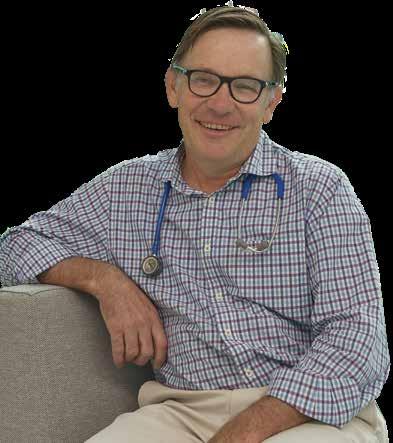
“As a clinician researcher, it’s my privilege to be involved in helping develop the next generation of vaccines that will improve health in children being born now and in the future in Western Australia. It’s gratifying to see the research having a direct impact on national policy and leading to more availability of vaccines for children,” he said.
“We also recognise that research is about working together to get the best evidence.
“We know the best evidence comes from randomised clinical trials, and we’re pleased to be one of Australia’s leading research groups helping to generate that evidence.”
IMPACT REPORT 2023 19
Modelling shows the relative abundance of three mosquito vector species across Africa
Website for parents of trans youth to save lives
A new website for parents of trans children and young people across Australia is expected to improve family wellbeing and ultimately save lives after launching in May 2023.


Transforming Families is a digital hub hosting videos, fact sheets and local service options, following its two-year development in collaboration with parents and communitybased service providers.
The need for targeted parental support was first identified in 2017 following the release of Trans Pathways, a first-of-its-kind report that surveyed 894 trans young people and 194 parents of young trans people.
“Parents surveyed then revealed they struggled to understand and support their child’s gender identity due to a woeful lack of support and services,” Telethon
Kids Institute Research Assistant Dr Helen Morgan said.
In qualitative studies conducted by the team, parents reported that they struggled to access reliable information about gender diversity, were unaware of peer support that might help alleviate feelings of isolation and they could not access competent care for their families.
Evidence-based support for families
Supported by a grant from Healthway and led by Dr Morgan and Dr Yael Perry – CoHead of Youth Mental Health at Telethon Kids - Transforming Families was developed with significant involvement from national and local partner organisations and, most importantly, parents.
“It really has been led by those with lived experience of what they need,” Dr Morgan said.
Dr Perry said many of the parents who had been willing to talk to the team had been on quite a journey.
“Many of them did not start out supporting their child when they first came out to them. Initial reactions ranged from outright rejection, to ambivalence and acceptance. They were able to reflect on that experience and harness it to provide recommendations of what might help others in a similar position.”
In efforts to counter misinformation and provide practical support for parents, Transforming Families features research summaries written in accessible language and with direct links to empirical studies. There
are also scripts to help parents ask questions at their local GP and navigate conversations with schools and extended family members.
“We just wanted to make it really easy for parents to get all the information they need in one place, in a really quick, digestible and easy-to-use format. We want to support them to make good decisions for their family and eliminate unnecessary distress on the path to understanding their child,” Dr Perry said.
Next steps
► Researchers will evaluate the impact of the site on outcomes including parent’s mental health and their ability to advocate for and support their child
► Findings from Parent Pathways, the first national study exploring the impact of having a trans child on parent mental health and wellbeing, will be published later this year
► Next, a program of research will be planned into the mental health and wellbeing of the siblings of trans children
Funding for Transforming Families is provided by Healthway. The project is a partnership between Telethon Kids Institute, Transcend Australia, Parents of Gender Diverse Children, ACON, the Commissioner for Children and Young People Western Australian, Transfolk WA, The Gender Centre Inc, the Freedom Centre, the Perth Inner City Youth Service, Healthway and Youth Focus
IMPACT REPORT 2023 | 21
Left: 17-year-old AJ and their mother Chenara were among those who helped make the Transforming Families website a reality
Nourish resources good for the body and the soul
Eating the food we need to stay healthy and strong is a straightforward, everyday act for most members of the population. But for thousands of children around Australia with intellectual and other disabilities, the process of eating can be traumatic, posing challenges that veer from uncomfortable to life threatening.
Trouble chewing and swallowing and nasal or gastro-oesophageal reflux are common in children with severe disability – often leading to poor growth and a higher risk both of aspiration of food and liquid into the lungs, and recurring chest infections.
“Mealtimes for these families can be distressing – not only for the child, but for parents who can see their child isn’t getting the nutrition or medication they need,” said Telethon Kids Institute Child Disability Head, Associate Professor Jenny Downs.
Families in this situation may opt for a gastrostomy, a reversible surgical procedure which allows for a feeding tube to be placed directly into the child’s stomach.
“Even though our research has shown many benefits from gastrostomy, both for children’s physical and mental health, it can be difficult for parents to make the decision,” Associate Professor Downs said.
Those who do choose gastrostomy may feel concern over the procedure itself, how they will learn the skills needed to manage feeds, and what it will mean for their child’s ability to live a full life.
Now, a first-of-its-kind online resource called Nourish – developed by Telethon Kids with families, Developmental Disability WA (DDWA), and Perth Children’s Hospital (PCH) clinicians and gastrostomy nurses – is not only helping parents through the decision process, but easing the transition for those who go ahead.
Launched in September 2022 and hosted on DDWA’s website, Nourish provides
Life-changing decision helping Samuel to thrive
information tailored to families and carers in the form of videos and ‘Ask and Do’ exercises. Parents feature in many of the videos, discussing why they chose gastrostomy, the life-changing difference it has made, and tips and tricks they’ve learned.
The resources have been shared with schools, care facilities, and clinical specialist nurses in other fields, and are now automatically provided to families following in-person and telehealth gastrostomy consultations at PCH.
Associate Professor Downs said the feedback had been overwhelmingly positive, particularly among parents and organisations supporting families living with disability.
Next steps
► More than 5,000 children born each year in Australia will grow up with intellectual disability
► Children with severe disability often have eating difficulties that stop them getting enough calories or medication
► Gastrostomy is a procedure which allows for a feeding tube to be placed directly into the stomach
► More than 300 WA children and around 3,000 children across Australia live with a gastrostomy
► Since being launched in 2022 the Nourish videos have been viewed more than 1,000 times
► Find the Nourish resources at ddwa.org. au/online-learning-directory/nourish-course/
Nourish was funded by an anonymous bequest to Telethon Kids Institute, facilitated by the Department of Communities
For Perth mum-of-three Natalie Hevron, the word ‘gastrostomy’ is interchangeable with ‘godsend’.
She and husband Matthew decided to try the procedure for their eldest son, Samuel, who was born with Down syndrome, to counter persistent feeding problems that were hampering his ability to take in enough nutrition to grow and thrive.
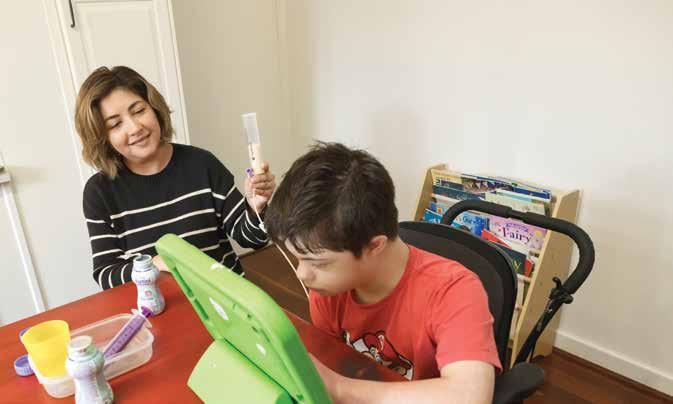
Now 13, throughout his short life Samuel has endured countless hospitalisations –including for open heart surgery at five months of age and leukaemia at 18 months.
“Samuel has quite a complex mix of issues which, put together, make it harder for him to swallow,” Natalie said.
“He was getting a lot of nasal regurgitation and could only manage soft purees and foods like yoghurt. The more he ate, the more it would go up his nose and the more he would sneeze it out. It was awful and uncomfortable for him, and he was getting sinus infections.”
Samuel underwent his gastrostomy in 2019, and while navigating the new feeding process was initially difficult, the results have spoken for themselves.
“For one thing no longer had to make such a massive quantity of blended food and try to have Sammy eat it. But more importantly he started putting on weight and his development increased dramatically,” Natalie said. “It was quite amazing watching that change and how much he actually needed that – since then he’s just gone up and up.”
Natalie shared her family’s experiences with Associate Professor Downs and team to help them develop Nourish, a set of resources designed to support families and health and allied professionals on the gastrostomy journey.
“Nourish didn’t exist when we first contemplated a gastrostomy and we had to figure a lot out through trial and error, and speaking to different parents to try to gather the information we needed,” she said.
“Simple things like how do you order the feeds and equipment, how do you store and wash your equipment, and can you use it again?
“There are so many practical things that have an impact if not dealt with – little things can turn into big things. Having practical solutions can provide a sense of control around a not-so-controllable situation.”
22 | TELETHON KIDS INSTITUTE IMPACT REPORT 2023 23
Natalie Hevron feeds son Samuel, who had a gastrostomy inserted in 2019
PARADIGM SHIFT
THIS RESEARCH CHANGES THE VERY WAY WE THINK
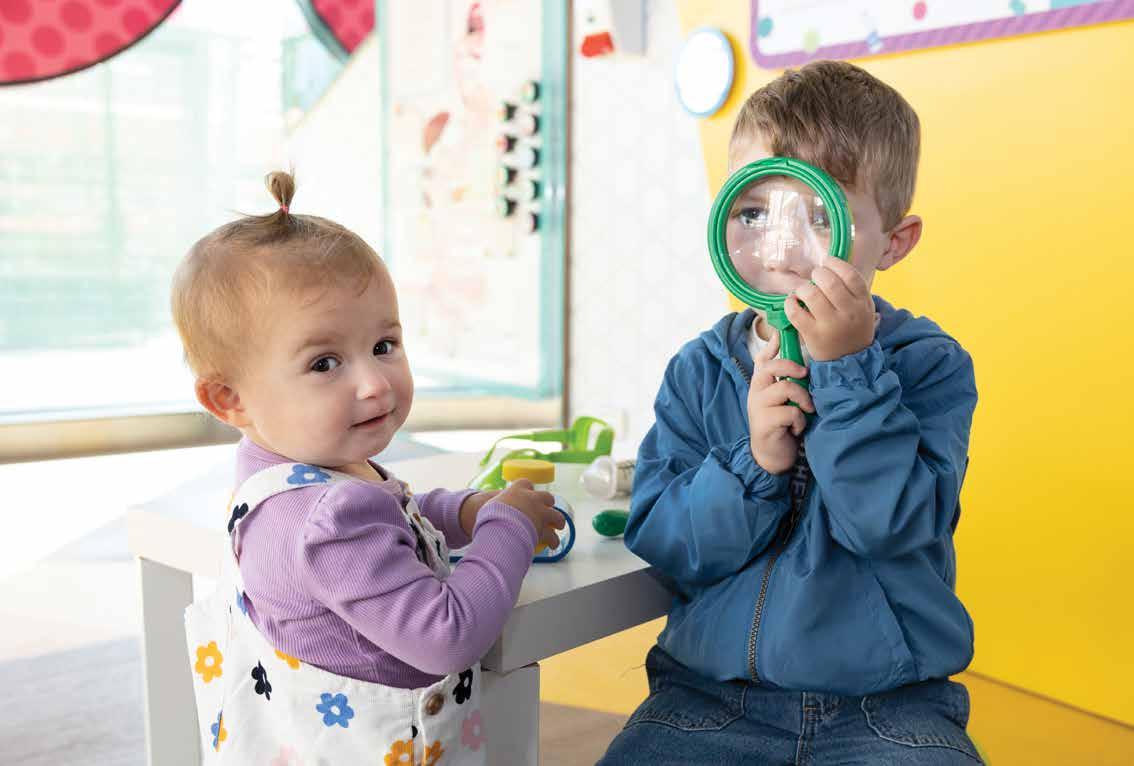
24 | TELETHON KIDS INSTITUTE IMPACT REPORT 2023 | 25
Jovie Candido, 18 months, with her three-year-old brother, Henley
Study spawns on-the-spot tests to help vulnerable groups
The AMR study led by Dr Barnett and student Mr Rodrigo has paved the way for point-of-care testing that will help health services in remote Aboriginal communities – which experience high prevalence of the types of infections caused by Strep A – to deliver faster, more effective care.
Working with Queensland-based collaborators, Mr Rodrigo is using the techniques honed during the study to develop a rapid on-the-spot test which can detect antibiotic resistance in under 15 minutes, as opposed to the 3-5 days currently required for laboratory testing.

“At the moment, by the time clinics in these remote communities get the results from
Breakthrough antibiotic discovery opens Pandora’s Box
It was dubbed humankind’s single greatest victory over disease, but less than a century on from Scottish physician Alexander Fleming’s 1928 discovery of penicillin, the world is perilously close to squandering the miracle of antibiotics.
Although still a staple of modern medicine, the benefits of antibiotics are swiftly waning thanks to overuse and the increasing ability of bacteria to dodge them – a phenomenon known as antimicrobial resistance, or AMR.
So serious is the threat, the World Health Organization predicts that unless radical action is taken, by 2050 AMR will cost the global economy $100 trillion and cause 10 million deaths every year.
“It’s no exaggeration to say that AMR is one of the most urgent public health problems facing the world today,” Dr Timothy Barnett, from the
Wesfarmers Centre of Vaccines and Infectious Diseases at Telethon Kids Institute, said.
“Without antibiotics, doctors will struggle to treat common bacterial infections, and life-saving procedures like surgeries and chemotherapy will be compromised.
“Unfortunately, we still know next to nothing about the mechanisms driving AMR.
“What we do know is that there’s no one mechanism and no one bacterial pathogen involved here – there’s still so much for us to learn if we’re to get ahead of this issue.”
Telethon Kids discovery
Telethon Kids researchers have, however, made a start.
In a breakthrough published in the journal Nature Communications earlier this year, a team led by Dr Barnett and PhD student Kalindu Rodrigo exposed, for the first time, a bug in the act of dodging antibiotics.
The team discovered a mechanism being used by Group A Streptococcus (Strep A) –a potentially deadly bacteria often found in the throat and on the skin – to bypass an antibiotic commonly used to treat Strep A skin infections.
The antibiotic (sulfamethoxazole) works by blocking the bacteria’s ability to make folate – an essential nutrient that allows the bacteria to grow and, in turn, cause disease.
“We found a mechanism of resistance where, for the first time ever, the bacteria demonstrated the ability to take folates directly from their human host when blocked from producing their own,” Dr Barnett said.
“This renders the antibiotic ineffective – but what’s worse is this mechanism is only active inside the host and it can’t be detected by the methods currently being relied on in Australian pathology labs to determine antibiotic susceptibility.
“So, while the lab tests are saying this antibiotic should work – in reality the infection keeps getting worse and doctors can’t understand why.
“It makes it extremely difficult for clinicians to prescribe antibiotics that will effectively treat the infection.”
their swabs back from Perth, the patient will already have finished the course of antibiotics. If it was the wrong antibiotic –one the bacteria is resistant to – this delay will have allowed the infection to worsen,” Mr Rodrigo said.
“Our test will diagnose AMR more rapidly, allowing clinicians to know which antibiotics to avoid and which are more likely to be effective.
“This will transform their ability to treat infections, reducing the number of antibiotic treatment failures, preventing more severe infections, and halting the spread of pathogens in the community.”
Dr Barnett said while the finding was exciting, it was likely just the tip of the iceberg. “I think we’ve opened up a Pandora’s Box – it really could be far bigger than what we first thought,” he said.
“We now have a student testing several different types of bacteria and multiple antibiotics, using tools developed through this study, and we’ve already found evidence of at least three additional mechanisms across multiple bacterial pathogens. The more we look, the more we find.”
He said while the techniques developed by the team so far were enabling them to dig further than previously possible, they were well aware they still didn’t have all the tools needed to detect what may be going on for other antibiotics and other pathogens.
“My big wish for the scientific community now is that this discovery spurs others to go looking further, in their own specialist areas, so that together we can grow what we know and find new ways to combat AMR,” Dr Barnett said.
This work was supported by the National Health and Medical Research Council, Western Australia Child Research Fund, Telethon Perth Children’s Hospital Research Fund and Wesfarmers Centre of Vaccines and Infectious Diseases. Dr Barnett is supported by a fellowship from the Western Australian Future Health & Innovation Fund
26 | TELETHON KIDS INSTITUTE IMPACT REPORT 2023 | 27
PhD student Kalindu Rodrigo and Dr Timothy Barnett discovered a new form of antimicrobial resistance
Giving kids with CF a chance at a longer, healthier life

Diagnosed with cystic fibrosis (CF) at three weeks of age, Connor Barrett’s daily routine involves 25 separate doses of medicine and two sessions of chest physiotherapy.
It’s all necessary to help this happy, clever kid – who dreams of one day becoming a medical scientist – to breathe better and reduce the damage to his lungs and digestive system caused by what will be a lifelong disease.
Children living with CF have a build-up of thick mucus in their lungs, making them prone to severe lung infections. Whenever Connor becomes unwell with a lung infection, he must endure an extended spell in hospital being treated with IV antibiotics.
“It’s a lot for a little boy,” Connor’s mum Taryn Barrett said. “While we are grateful for the medical research of the past, which is keeping Connor as healthy as he can be, there is still so much work to be done.”
It is for this reason that Taryn became an advocate for cystic fibrosis research – and why she decided Connor should take part in the Telethon Kids Institute-led COMBAT CF trial.
COMBAT CF is one of two long-standing international trials which have resulted in new early intervention options that hold great promise for reducing progressive lung damage in kids living with CF.
Reducing hospital stays
The decade-long COMBAT CF trial followed 130 children from CF clinics across Australia and New Zealand, from the time they were diagnosed at birth until they turned three years old, to see if using the commonly prescribed broad spectrum antibiotic, azithromycin, as a preventive therapy could reduce lung inflammation – and thus alter the course of the disease. Lung inflammation is associated with progressive lung disease in young children with CF.
Children involved in the study were given either the antibiotic treatment or a placebo,
with the trial finding that those who had received the antibiotics had less lung inflammation and did not get as sick as frequently as those in the control group. This meant they spent fewer days in hospital and received fewer antibiotics each year than children given the placebo.
“Importantly, we found this treatment reduced inflammation in the lungs of young children, which is incredibly significant because there are no other antiinflammatory medications that are currently available to treat the lung inflammation that we see in these kids,” Wal-yan Respiratory Research Centre Director, Professor Stephen Stick, said.
The research team also found long-term use of azithromycin was safe and improved respiratory symptoms.
Effective, affordable treatment
The second trial, SHIP CT, aimed to identify effective and affordable therapies to prevent or slow development of structural lung disease which had already developed in a large population of children with CF aged between three and six years.
The study trialled the use of inhaled hypertonic saline – a saltwater solution with a higher concentration of salt than normal saline – as a treatment and found it was a safe, cheap, and effective option.
Using images of the lung from chest CT scans to measure results, the study showed children who inhaled hypertonic saline twice daily for 48 weeks exhibited less structural lung damage compared with children who inhaled isotonic saline – a saltwater solution with the same salt concentration as the body.
“This is the first evidence of a treatment that alters structural lung disease in children of this age group,” Professor Stick said.
New options for younger kids
Professor Stick described both the COMBAT CF and SHIP CT trial findings as promising,
with each offering a disease-altering early pathway to a group of children currently too young to access key medications –such as modulator therapies – which have transformed treatment in older children and adults with CF.
Modulator medication changes the way the CF gene works at a cellular level, making the body more efficient at clearing mucus so it does not build up – in turn giving the body a better chance at fighting infection. However, many young children in the world
do not have access to these transformative therapies.
“As interventions, we now know that both azithromycin and hypertonic saline hold great promise in terms of reducing the progressive lung damage we see in early CF,” Professor Stick said.
“They therefore give doctors another weapon to treat these kids until they are old enough and eligible for modulator therapies.”
The COMBAT CF study was co-led by Professor Stick, Director of the Walyan Respiratory Research Centre – a powerhouse partnership between Telethon Kids Institute, Perth Children’s Hospital Foundation and Perth Children’s Hospital – and Professor Peter Sly, of The University of Queensland. Professor Stick is also a researcher at The University of Western Australia’s Medical School and a respiratory clinician at Perth Children’s Hospital
COMBAT CF was funded by the Cystic Fibrosis Foundation and carried out in collaboration with the Child Health Research Centre at The University of Queensland, Griffith University, Erasmus University Medical Centre, Monash Children’s Hospital, The Children’s Hospital at Westmead, Women’s and Children’s Hospital, Starship Children’s Health, Sydney Children’s Hospital, Queensland Children’s Hospital, The Royal Children’s Hospital, and New York Presbyterian Hospital. SHIP CT was funded by the Cystic Fibrosis Foundation and carried out in collaboration with Erasmus University Medical Centre, Seattle Children’s Hospital, Indiana University, and The Hospital for Sick Children
28 | TELETHON KIDS INSTITUTE IMPACT REPORT 2023 | 29
Left: Connor Barrett
Photo by Dale Watson
Helping our smallest babies live their biggest lives
A new study is helping to identify treatment options to improve the lung function of babies born prematurely after it was determined survivors of preterm birth were at risk of declining lung health – debunking a long-held belief that they would grow out of their breathing problems.
Associate Professor Shannon Simpson, cohead of Children’s Lung Health at the Wal-yan Respiratory Research Centre, led a ground-breaking, decade-long study which five years ago found preterm babies’ lung function was at risk of worsening. This meant damage to the children’s lungs was ongoing and needed treatment.
Determined to improve the lung health of these children, Associate Professor Simpson and the Children’s Lung Health team secured funding for a new trial exploring the effectiveness of common asthma medication fluticasone, or ‘Flixotide’, in treating ongoing breathing problems in children aged six to 12 years-old, who had been born at less than 32 weeks’ gestation.
The Preterm Paediatric Inhaled CorticoSteroid Intervention (PICSI) study began in 2018 and, after more than three years of seeing families, the study team recruited its final participant in early 2022.
Throughout the study the team followed 87 children who were given the inhaled medication and another 83 who received a placebo.
All participants undertook a baseline visit consisting of a lung health questionnaire, lung function testing, and the collection of biological samples. They then took either Flixotide or a placebo twice daily for 12 weeks, before being followed up to assess any changes in their lung function.
The study results showed children born prematurely who were treated with
fluticasone over the 12 weeks experienced a modest improvement in lung function, with nearly one quarter (23 per cent) experiencing a significant improvement in their lung function. This suggested there is likely to be a subset of individuals born preterm for whom the treatment could be very effective.
Associate Professor Simpson said the results were significant and would help to guide the longterm clinical management of people who had prematurity associated lung disease.
“More than 15 million babies are born preterm each year, with over two million babies being delivered very preterm, at less than 32 weeks gestation,” Associate Professor Simpson said. “Most babies born before 32 weeks need help with breathing because their lungs are not fully developed.

“We also know that those very preterm infants surviving the neonatal period are at risk of significant lung disease throughout life.
“After these babies leave the NICU, there’s not currently a coordinated approach to long-term lung health follow-up, or any evidence-based treatments for those babies that are at risk of deteriorating lung function.
“Our research within the Children’s Lung Health team focuses on working out how we can intervene as early as possible to make sure these kids grow up with healthier lungs. And for the first time, we now have an evidence-based treatment that has been shown to significantly improve the lung function of a group of these kids in the short term.
“Our aim now is to build on this work, so that we can identify treatment methods to improve the management of lung disease of those born preterm, allowing them to breathe easy, and live their biggest lives.”
Did you know?
• Globally, more than two million babies are born at less than 32 weeks’ gestation every year
• Significant improvements in neonatal critical care throughout the 1990s drastically increased the survival rate of infants in this category
• Rates of preterm birth have increased in almost all countries over the past 20 years, including Australia, and now account for more than 11 per cent of births globally
• Bronchopulmonary dysplasia (BPD) – a chronic lung disease of prematurity - remains one of the most significant complications
Right: Children’s Lung Health Research Assistant Tiffany Bradshaw helps seven yearold Pierce Brazier undertake a lung function test. Pierce and his twin brother Aston were born premature
Next steps
► Further studies are needed to determine how to predict which kids will benefit the most from this intervention, and to trial fluticasone for a longer period of time to determine if extended use prevents lung function decline in this population

The study was funded by the Australian National Health and Medical Research Council and carried out in collaboration with the School of Allied Health and the School of Population Health, Faculty of Health Sciences, Curtin University, and the Department of Respiratory and Sleep Medicine at Perth Children’s Hospital
The Wal-yan Respiratory Research Centre is a powerhouse partnership between the Telethon Kids Institute, Perth Children’s Hospital and Perth Children’s Hospital Foundation
30 | TELETHON KIDS INSTITUTE IMPACT REPORT 2023 | 31
Miners breathe more easily thanks to research
Researcher Katherine Landwehr’s world-leading exhaust toxicology research, being conducted at Curtin University and the Wal-yan Respiratory Research Centre – a powerhouse partnership between Telethon Kids Institute, Perth Children’s Hospital and the Perth Children’s Hospital Foundation – has already led to policy changes aimed at protecting the health and safety of Australian workers.
In 2019 she was part of a working group commissioned by the WA Department of Mines which found diesel exhaust concentrations in underground mining exceeded safe levels.
The group’s report – written by Dr Landwehr as part of her PhD thesis – led directly to the establishment of occupational diesel exhaust limits in mining in Western Australia in 2020, with similar limits introduced in New South Wales in 2021.
“Prior to this, Australia had no occupational limits for diesel exhaust exposure, despite it being an acknowledged carcinogen since 2012,” Dr Landwehr said.
“Diesel-powered machinery is ubiquitous in the mining industry, so these changes have the potential to benefit nearly 200,000 workers every year in WA and NSW, by reducing the amount of diesel exhaust they’re exposed to daily.”
The Australian Council of Trade Unions wants to see regulators go even further, using Dr Landwehr’s research in a 2020 submission to Safe Work Australia calling for the establishment of national occupational diesel limits across all sectors.
Dr Landwehr has also presented her work to WA government departments and mining professionals, discussing which oil crops make the best biodiesel and outlining the devastating health effects that can follow occupational exposure to diesel exhaust – including cardiovascular disease and lung, bladder and brain cancers.
Did you know?
• Biodiesels are a renewable, biodegradable form of diesel fuel that can be made from almost any kind of animal or plant-derived fat or oil – even the leftover oil from a fish and chips fry-up
• Their use is growing worldwide as climate change concerns increase and mineral diesel becomes more expensive to extract
• Favoured for their perceived environmental benefits, biodiesels are often marketed as ‘green’, but concerns include the encroachment of biodiesel crops on land which could otherwise be used to grow food
• They are commonly used in Australia, although consumers may not know it. Diesel fuel available at the pump can include a blend of up to 5 per cent biodiesel without requiring labelling
Next steps
► Dr Landwehr is researching and writing the national Thoracic Society of Australia and New Zealand’s position statement on air pollution, which will push for indoor air pollution controls in Australia
This work was supported by the Australian Research Council, Stan Perron Charitable Foundation, and Curtin University’s School of Population Health
Biodiesels not as clean and green as they seem
In a world being urged to embrace renewable options, biodiesel fuels – made from plants and animal byproducts – are increasingly touted as a greener, cleaner choice than traditional diesel.
But world-first evidence being produced by a Telethon Kids Institute and Curtin University researcher has raised questions about the health impacts of these seemingly friendly products.
Dr Katherine Landwehr’s work has, for the first time, shown not all biodiesel fuels are equal, with the exhaust from some –especially biodiesel made from beef fat – producing more toxic health effects than others.
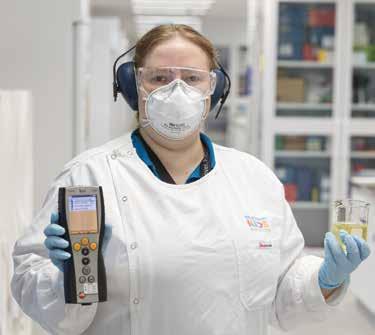
“Prior to my research, all biodiesel was treated as interchangeable and there was virtually no consideration of its potential to impact health,” Dr Landwehr said.
“My work has shown not only that there is a spectrum of toxicity depending on the type of oil or fat used to make the biodiesel, but that some types are even more toxic than mineral diesel – a known carcinogen.”
Her findings have revealed even short exposures to diesel and biodiesel exhaust can have toxic effects.
In a study published this year, mice exposed for just two hours a day for eight days to diesel and beef tallow biodiesel exhaust, at levels typical of a mining setting or alongside a busy road, exhibited a dampened immune response and showed evidence of lung damage and ‘hyperreactivity’ – a response similar to that seen in asthma.
“We saw a decrease in some types of immune cells and immune cell signalling,
which suggests immune dysregulation in the lungs after breathing in exhaust for this long –and that’s a concern,” Dr Landwehr said.
“They’re effectively using up their reserves of immune function to handle the exhaust, which means they are less likely to be able to deal in the normal way with, say, a virus or cancerous cells that may appear.
“Exposure to tallow diesel also led to some airway damage. Our imaging found slightly increased space in the lungs, which suggests some alveolar deterioration – the same kind of irreversible damage you see from longterm cigarette smoking.”
Conversely, mice exposed to canoladerived biodiesel displayed less severe negative effects in the lungs and immune cells – evidence which backs up Dr Landwehr’s earlier findings that canola biodiesel consistently produces fewer toxic side effects, while beef tallow produces the most.
Dr Landwehr said the next step would be to explore better biodiesel regulations, including labelling.
“Current regulations are more about how biodiesels impact vehicle engines and how well they lubricate the fuel, rather than broader impacts. We urgently need to start paying more attention to the health impacts of these fuels.”
32 | TELETHON KIDS INSTITUTE IMPACT REPORT 2023 33
Katherine Landwehr gets ready to test a biodiesel sample
COLLABORATING FOR IMPACT
THIS RESEARCH SHOWS HOW WE WORK WITH OTHERS TO MAKE A DIFERENCE
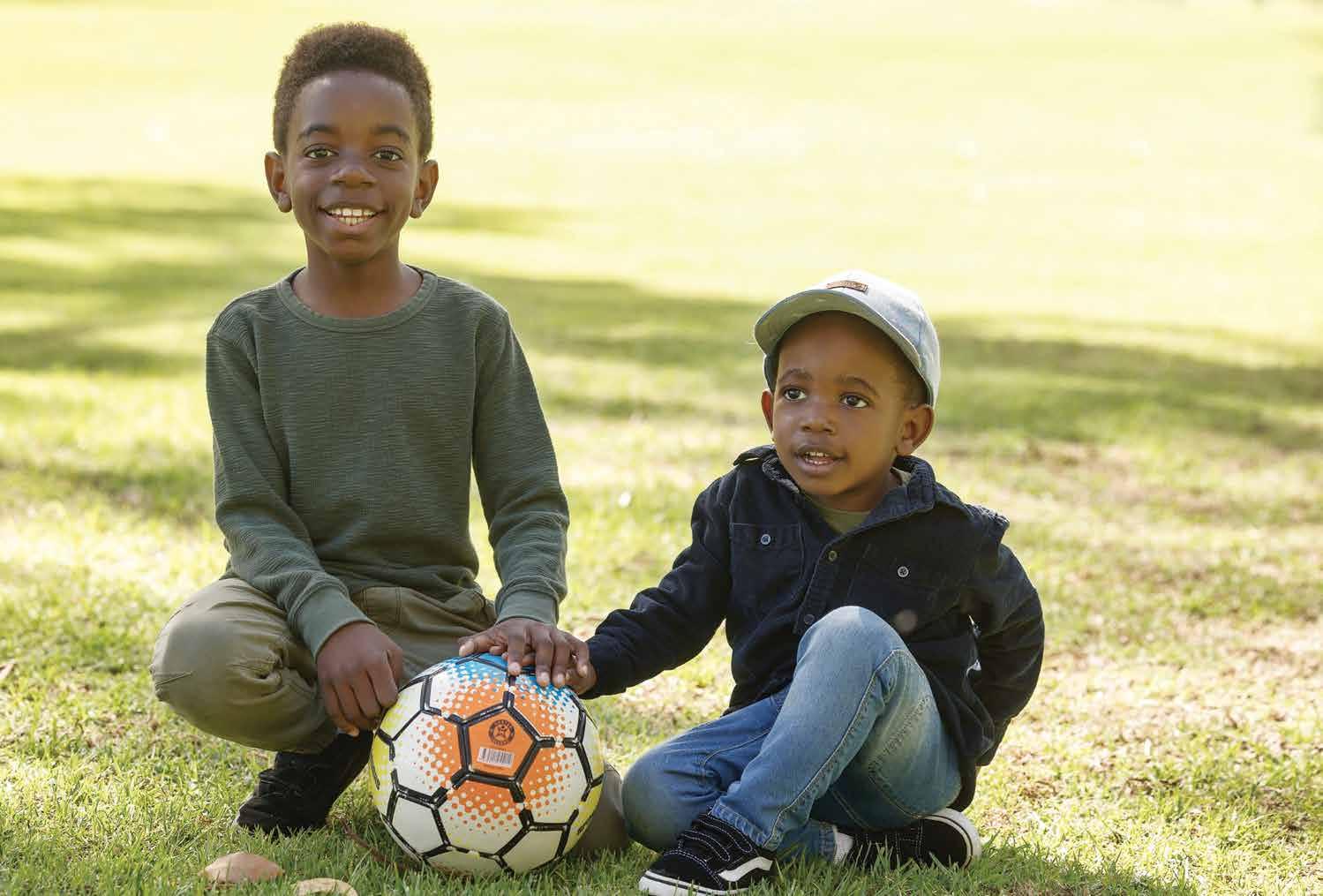
34 | TELETHON KIDS INSTITUTE IMPACT REPORT 2023 35
Ntando Ncube, 7, and three-year-old Sandile Ncube
On the road to recovery
In late 2022, six-year-old Megan Hutton was living the dream of many kids her age as she celebrated being named runner-up champion athlete at her school sports carnival.
A month later, this healthy, active child was in a coma at Perth Children’s Hospital after a case of Strep A pneumonia developed into sepsis.

“She started out with cold and flu-like symptoms, which continued for a few days but were nothing out of the ordinary,” Megan’s mother Ali Hutton said.
On day four Megan became lethargic, then started to quickly deteriorate. Rushed to the ED, she spent 22 days in hospital, including 12 in intensive care.
“It was a pretty sharp decline,” Ali said. “We have a video she took of herself hours beforehand and she was dancing around – less than 24 hours later she was in a coma. We didn’t know she had sepsis until she was in the ICU.”
Megan – who turned seven under the watchful eyes of the Starlight Children’s Foundation clown doctors on the ward – is now back to herself but her progress is being closely monitored.
Stamping out Strep A
The race for a vaccine
The holy grail in Strep A research is a vaccine and Telethon Kids is leading the charge worldwide. The Institute is home to the Australian Strep A Vaccine Initiative (ASAVI), a partnership with the Murdoch Children’s Research Institute which is working to fast-track a safe, effective vaccine to prevent Strep A infection.
Eliminating RHD
In 2020, the END RHD national research consortium, led from the Institute, released the Endgame Strategy, a blueprint laying out the strategies needed to eliminate RHD in Australia by 2031.
Global policy
Researchers including Professor Carapetis, Associate Professor Asha Bowen and Associate Professor Hannah Moore are part of the Strep A Vaccine Global Consortium (SAVAC), which has spearheaded best practice protocols that will unite efforts to create a Strep A vaccine.
Community-led approaches
Our researchers work closely with Aboriginal communities to co-design our research and resources, including those to tackle skin infections and developing new ways of delivering penicillin prevention.
On-the-spot diagnosis
We are discovering new diagnostic methods that can help people, especially those in remote areas, receive faster and more effective care.
Improving treatment
Penicillin, the world’s oldest antibiotic, remains the cornerstone of treatment for those exposed to Strep A. Used both to prevent complications and treat rheumatic fever and RHD, treatment currently involves painful monthly injections that can deter people – especially children living in remote areas – from maintaining treatment. Our researchers are working to develop new and improved formulae of penicillin that will be longer acting and easier to administer.
Deadly bug in researchers’ sight at Telethon Kids
It’s the sixth most lethal pathogen on the planet, affecting at least 40 million people globally, and killing more than half a million people each year.
Group A Streptococcus, or Strep A –a bacterium which lives in the throat and on the skin – causes the broadest range of diseases of any bug, leading to consequences that run the spectrum from mild to catastrophic.
“I often say it’s the nastiest bug you’ve probably never heard of,” Telethon Kids Institute Executive Director Professor Jonathan Carapetis said.
“It can cause everything from sore throats and skin sores, which are very common but not so severe, through to nasty infections which can kill you in a short time, such as sepsis or flesh-eating bacteria.
“But it also has unique features that activate the immune system and cause serious, lifeshortening diseases like rheumatic fever, rheumatic heart disease (RHD) and kidney disease.”
Strep A is a worldwide problem but the burden falls most heavily on vulnerable populations including Aboriginal and Torres Strait Islander peoples in Australia, who experience some of the highest rates of RHD and Strep A sepsis in the world.
“The devastating impact Strep A has on so many lives, including right here in Australia, puts it at the top of the league table of bugs we need to deal with,” Professor Carapetis.
It’s this urgency that is driving large swathes of research at Telethon Kids Institute.
The Institute has become one of the world’s leading Strep A hubs, with multiple teams working in the Institute’s END RHD Program, headed by Associate Professor Asha Bowen, working to understand how Strep A works
and find better ways to prevent and control the diseases it causes.
“We know there’s no single solution for Strep A so our researchers are tackling it from every possible angle,” Professor Carapetis said.
“From the lab to the bedside, from communities to health services and governments, our teams are working to accelerate research, advocate and change policy, and improve the lives of people affected by Strep A.
“We’re also working collaboratively with others because we know there’s no one organisation or one individual who can do this on their own. We’re doing this together.”
Did you know?
• Group A Streptococcus, or Strep A, is a type of bacteria responsible for a range of diseases – from mild infections such as pharyngitis (sore throat), and impetigo (skin sores), through to severe diseases including acute rheumatic fever, RHD and sepsis
• Strep A infections and associated adverse consequences cause an estimated half a million deaths globally every year, mostly in young adults. RHD alone affects nearly 40 million people and is responsible for at least 340,000 deaths per year
• Strep A infections can become life-threatening very quickly if the bacteria invade the body’s blood stream, muscles or lungs. This is known as invasive disease
Vaccine development is supported by Open Philanthropy
36 | TELETHON KIDS INSTITUTE IMPACT REPORT 2023 | 37
SToP-ping skin sores in the Kimberley
More than 3,000 skin checks have been undertaken as part of a large clinical trial in Western Australia’s Kimberley region aimed at halving the burden of skin sores in school-aged Aboriginal children living in remote areas.
The See, Treat, Prevent Skin Sores and Scabies (SToP) Trial, a collaboration between the Telethon Kids Institute, Kimberley Aboriginal Medical Services, WA Country Health Services –Kimberley and Nirrumbuk Environmental Health Services, has also developed healthy skin resources co-designed with nine participating communities.
Healthy skin books have been developed with Warmun, Balgo, Mulan, Billiluna, Bidyadanga and Ardyaloon communities. A hip-hop music video promoting healthy skin was also produced with Ardyaloon, Djarindjin, Lombadina and Beagle Bay communities.
SToP Trial Research Assistant and PhD Candidate Tracy McRae said the 85 community members involved in the development of resources came up with original ideas, determined the most important messages, painted artwork, translated resources into local languages, shared traditional knowledge, and ultimately launched the resources.
“Each resource was driven by community members, from the very conception of the idea,” Ms McRae said. “Some of the resources have only been completed in the last few months, so it has been a long, involved and wonderful process over many years.
“There has been nothing more important than listening to, hearing, and understanding the voices of communities in our work, because it is all about developing community-owned and led solutions to maintain strong, healthy skin.”
“The process of working on the resources together has not just resulted in healthy skin resources for each community, it has also resulted in so many strong relationships, a twoway trust that we share a common goal of healthy skin for all kids, and a lot of learning on our behalf about what the reality of skin health looks like in the context of everyday life,” SToP Trial Postdoctoral Research Officer Dr Hannah Thomas said.
Unlocking the benefit of genomics for Indigenous Australians
Scientific discoveries over the past 30 years mean doctors now have a deeper understanding of what causes disease and how those diseases might progress.
Advances in genomic medicine – analysing a person’s unique genetic makeup to tailor diagnosis and treatment – have helped to diagnose disease, decode complex illnesses and predict a person’s risk levels for a vast array of conditions.
But Indigenous Australians have been left behind by a system of scientific advancement that has not been designed to respect their complex cultural history.
There is no clear picture of the genomic landscape of Aboriginal and Torres Strait Islander Australians, which means they’re missing out on the potential advantages genomic medicine can deliver.
Telethon Kids Institute and Australian National University’s Professor of Indigenous Genomics, Professor Alex Brown, is on a mission to change that.

He is leading the establishment of a national network - The Australian Alliance for
Next steps
► Working with communities and collaborators to translate the resources and results into meaningful and culturally appropriate and informed tools and output
► Translating the healthy skin books into audiovisual and interactive PDF versions for classrooms
► Translating Healthy Skin school workshops into a curriculum-linked teacher toolkit
► In July/August – taking the results of the trials to all communities for co-interpretation workshops, with visual outcomes.
Professor Alex Brown said improving access to genomic medicine for Indigenous Australians is a significant part of the Closing the Gap strategy
Indigenous Genomics (ALIGN) - to advance the benefits from Genomic Medicine for Aboriginal and Torres Strait Islander people, in collaboration with researchers, genetic health services, Indigenous communitycontrolled health organisations and industry partners across the country.
“We know that Indigenous people the world over have been largely excluded from this genomic picture for a raft of reasons,” Professor Brown said. “Some relate to a low level of trust from communities in the scientific endeavour, based on a history of exploitation of Indigenous people.”
Genomics can unlock the information in our DNA to enable personalised, targeted approaches to the prevention and treatment of a range of health conditions including cancer, diabetes and heart disease, as well as rare diseases.
Professor Brown said the national alliance would advance the benefits of genomic medicine for Aboriginal and Torres Strait Islander patients, who have so far been excluded from national genomics efforts.
“Little attention has been paid to the steps required to ensure Indigenous Australians can and do benefit from all that genomics has to offer,” he said.”
The national alliance will comprise six strategically located ‘nodes’ in Queensland, New South Wales, the ACT, Western Australia, Victoria and South Australia.
Professor Brown said the national network aims to improve Indigenous engagement with genomics by building a culturally safe framework that respects the traditions and beliefs of Aboriginal people who may choose to engage with genetic research and health care.
The national network project is funded by the National Health and Medical Research Council
38 | TELETHON KIDS INSTITUTE IMPACT REPORT 2023 39
children BBQ sausages
skin and throat swabs transported to Perth
driven across the Kimberley 59 travelling team members and volunteers 241 school and 184 clinic staff trained 8 health promotion resources created Over 85 community members involved, 110 litres of bubble mix 8 schools
skin checks at 125 interviews and yarns 12 took part in training DR Capital and INPEX support
915
1,036
45,000km
3,084
Telethon Kids in the Kimberley
Study gives life to research projects
Currently, more than 40 independent projects have emerged from the ORIGINS project, with 15 more in the pipeline. Many are making ground-breaking initial findings. We highlight four of these studies below.
Virtual dental checks
A Dental Screening study enabled ORIGINS parents to use a mobile phone to take a photo of their child’s teeth and upload it to an app for remote assessment by dental professionals.
The app enabled high-accuracy screening of healthy children without tooth decay, as well as those with evidence of cavities.
The feasibility study was led by researchers from The University of Western Australia, Dr Somayyeh Azimi, Dr Jilen Patel and Dr Mohamed Estai. The app has ongoing potential for use to overcome barriers of distance for remote communities with a lack of local dental services.
Making the most of screen time
Screen ORIGINS is investigating how families engage with screen technologies and how this may influence child development.
Lead author Dr Rebecca Hood, from Curtin University, said interviews with ORIGINS parents revealed that looking at pregnancy information and apps on their device helped many parents-to-be feel connected to their baby, by giving them a better idea of what was going on. However, using devices for unrelated tasks, such as social media, led to a sense of disconnection from their baby.
Positive engagement through nature
A park play program has helped ORIGINS families to learn about the importance of connectedness to nature for young children.
The Nature Play & Grow program, run in collaboration with Nature Play WA, addresses the trend towards passive screen-based
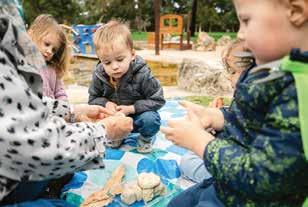
indoor activities — with an associated rise in psychological disorders, chronic disease and a disconnect from the natural environment.
Families met weekly in local parks, participating in outdoor play, healthy eating, physical activity and child development activities. Sessions were facilitated by a child health and developmental ‘play’ expert. They were also asked to listen to weekly educational podcasts and complete questionnaires about their experience.
An evaluation of the program showed both parents and children benefited from participation in the program.
New thinking on food allergies
The PrEggNut and SYMBA studies are examining whether the food a mother eats during pregnancy and breastfeeding affects the chances of her baby developing food allergies.
It was previously thought that babies and children should avoid common allergic foods such as peanuts and eggs, to prevent the development of allergies. But new studies, including one nested within The ORIGINS Project and led by Associate Professor Debbie Palmer - Program Head of Early Life and Life-Course Health at Telethon Kids Institute – have found the opposite.
Initial findings have shown that the early introduction of common allergen foods during pregnancy or earlier in childhood can actually tolerise the baby, so the child has a reduced chance of developing allergies.
The ORIGINS Project: A platform for research discovery
The ORIGINS Project is a decade-long longitudinal study of more than 18,000 individuals including mothers, partners and children, as part of a collaboration between Telethon Kids Institute and Joondalup Health Campus.
Through the study of early environments, maternal physical health and genetics, ORIGINS aims to uncover how, when and why chronic conditions such as asthma, obesity, allergies and poor mental health develop.
Collecting data and biological samples to create one of Australia’s largest data and biobanks, the project is following the progress of pregnant women and their families for the first five years of the child’s life, fuelled by an increasing understanding that an individual’s lifetime health and disease may be programmed at a very early stage – while a child is still in the womb.
The samples and information being collected from complete family units are creating a rich resource in the ORIGINS Biobank, which contains more than 350,000 biological samples linked to more than 16 million data points.
Real-time feedback provided to participant families also allows for early intervention if health or developmental issues are identified.
Now in its sixth year, The ORIGINS Project reached a milestone in 2023, completing recruitment of all active participants.
The ORIGINS infrastructure provides a framework for the integration of sub-projects, nested within the main observational cohort. This saves researchers time and money, enabling faster results and research translation. As well as facilitating strategic long-term research capacity, ORIGINS is a pipeline for short-term productivity through a series of clinical trials, early interventions, mechanistic studies and targeted research questions to improve maternal and paternal health and the early environment of the child.
Information is being used by researchers around the world to identify and implement ways to reduce risks for children and will be accessed for many years to come.
The ORIGINS Project is funded by the Paul Ramsay Foundation and the Commonwealth Government of Australia through the Channel 7 Telethon Trust
40 | TELETHON KIDS INSTITUTE IMPACT REPORT 2023 | 41
ORIGINS at a glace 42 nested sub-projects One third of active ORIGINS pregnancies have already had at least one sample used for research 7,476 biological samples have been distributed to 11 projects 18 ORIGINS sub-projects have received data extracts 7,370 Birthing Women 8,212 Babies Born 2,512 Non-Birthing Partners Almost 3,000 children have had a clinical assessment at one-, three- or five-years of age
Worrying findings lead to new project to help fathers flourish
New dads can feel undervalued and face significant health and mental health risks following the birth of a child, according to new research that has prompted a rethink about how to address the often-unmet needs of fathers.
The findings were made as part of a wider study evaluating the health of new and expectant fathers, with a particular focus on the risk of diabetes and cardiovascular disease.
The CARE-Dads study involved 498 male expectant or new fathers and aimed to provide them with a health check-up.
Fathers were recruited through The ORIGINS Project, a collaboration between Telethon Kids Institute and Joondalup Health Campus, which examines how the early environment can have an impact on the development of a wide range of conditions, such as asthma, obesity, poor mental health, and allergies, in both the child and their parents.
Health data collected on the new and expectant fathers between December 2017 and April 2020 found that of these new dads:
46 per cent were overweight and nearly one in three was obese
A quarter had high blood pressure
11 per cent had high cholesterol
6 per cent had pre-diabetes
40 per cent had low Vitamin-D levels
14 per cent had moderate, severe or very severe levels of depressive, anxiety or stress symptoms
Nearly one in ten were flagged for urgent follow-up (physical or mental health)
Professor Desiree Silva, Director of The ORIGINS Project, led the study alongside Professor Bu Yeap, a consultant endocrinologist and Professor with the Medical School at The University of Western Australia.
Support networks important for new dads
Jacob Hammer is one of 600 fathers who will be recruited to the Flourishing in Fatherhood project when it starts in mid-2023.
Dad to three-year-old Hugo and 18-monthold Aria, Mr Hammer said the transition to fatherhood could be tough.
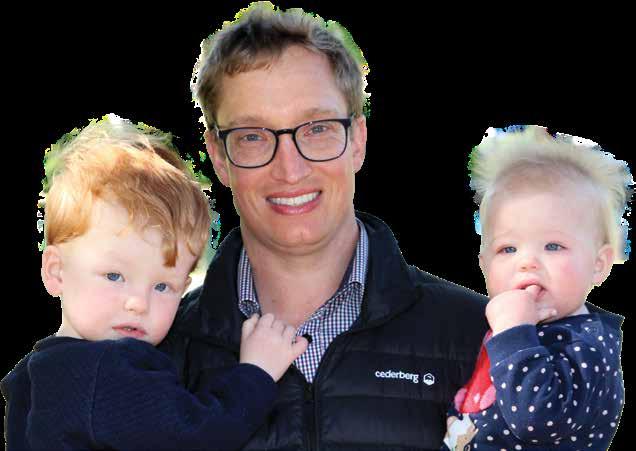

“When Hugo was first born, I felt like was giving up a part of my life, even though I was gaining so much, too. did find it quite hard,” Mr Hammer said.
“Cycling and training were a big part of my life, and just didn’t have the time for it when he first came along. It took some adjustment; life just became a lot more complex.
“It was tricky when Cara, my wife, was breastfeeding, as there was only so much I could do given the baby was always attached to her.
“I did meet up with a few other dads initially, mostly the husbands of the mothers’ group, and it was good to share our experiences, but the support network just isn’t there for dads as it is with mums, I think.”
In
for
“These findings indicate that expectant fathers have substantial cardiometabolic and mental health risks,” Professor Silva said.
“Whether these conditions improve or deteriorate following the birth of their child, how frequently new issues arise, and to what extent these are detrimental to the wellbeing of partners and development of their children, is unclear.”
Professor Yeap said the effect of early referral of expectant fathers with identified issues on their longer-term health was unknown.
“Hence, our ability to help expectant fathers to flourish before and after birth of their child, and improve outcomes for their families, is currently limited.”
The Flourishing in Fatherhood project has now been developed to build on this previous research.
The project aims to address the dearth of knowledge about new fathers and is looking at the challenges to mental and physical health fathers face during their transition to parenthood, along with the impacts these have on the wellbeing of partners and the growth and development of children.
“While antenatal programs help pregnant mothers live healthily to enhance pregnancy outcomes, expectant fathers are often
treated as secondary to fertility, birthing and parenting processes,” Professor Silva said.
“Our ORIGINS fathers and non-birthing partners have reported that they feel undervalued or irrelevant to the process of having a child. It is all about mum, which is important of course, but the impacts of this on fathering and children are poorly understood.”
The study will also pilot a program to help fathers to improve lifestyle behaviours, such as eating habits and exercise, which can improve their overall health and lose weight if necessary.
“There have been a number of studies that have shown that fathers provide important influences on child development in ways that are unique and independent to those of mothers,” Professor Yeap said.
“However, there is little research into the health of expectant fathers, their post-natal health trajectories, and the impacts of this on fathering and children. Therefore, the Flourishing in Fatherhood project will address an important gap in knowledge.”
Professa Silva said fathers who were able to proactively manage their health may become healthier and happier and therefore better partners and fathers.
Next steps
► Results from the project could determine if a simple screening based on questionnaire responses, physical assessment and a blood test, with the provision of a report and recommendations for GP follow-up of specific issues, is beneficial to expectant fathers
► This could be readily adopted as a joint initiative with GPs to develop an antenatal screening/ education program, designed in conjunction with expectant fathers, to run in parallel with current maternal antenatal care provision
Right: Hugo, Jacob and Aria Hammer
an inaugural partnership
Telethon Kids, HBF is providing three years of funding for the Flourishing in Fatherhood project
42 | TELETHON KIDS INSTITUTE
IMPACT REPORT 2023 43
Perth dogs helping to fight cancer
Immunotherapy is the new holy grail of cancer treatment – using the patient’s own immune system to fight the disease. But this revolutionary therapy has had little impact on solid tumours like sarcoma, the third most common cancer in children. Now, a world-first trial at Telethon Kids Institute could change that – all with the help of man’s best friend.
The busy pre-surgery area of Perth Veterinary Specialists in Osborne Park is perhaps the last place you’d expect to be ground zero for a clinical trial that could save the lives of thousands of kids around the world.
This is where three-year-old bulldog, Maggie, is waiting to go under the knife to remove a small but potentially deadly sarcoma tumour on her back and earn herself a place in medical research history.

Maggie is one of a handful of dogs selected to trial a cutting-edge new treatment for sarcoma. A polymer-filled gel, loaded with immunotherapy drugs, will be applied inside the wound when the skilled vet surgeon removes her tumour. She’ll then be stitched up and sent home, while the gel kicks her canine immune system into action.
This clinical trial in Perth dogs is the brainchild of Associate Professor Joost Lesterhuis, Head of the Telethon Kids Cancer Centre.
“Surprisingly, sarcoma in dogs presents similarly to sarcoma in humans. The treatment is much the same – surgery to remove the tumour. In kids, this is followed
by radiotherapy and chemotherapy,” Associate Professor Lesterhuis said.
“But it’s not a perfect treatment. The cancer can come back in the same spot. Invisible cancer cells make their way into the surrounding tissue, so it’s impossible for a surgeon to know if they’ve got all the cancer.”
The immunotherapy gel is designed to mop up those remaining cancer cells by activating the body’s own immune system and drawing immune cells to the site of the cancer.
Associate Professor Lesterhuis said the gel, developed with the help of chemists at The University of Western Australia, could revolutionise the way solid tumours were treated.
“This could not only improve survival rates, but it could also allow doctors to reduce the amount of chemotherapy and radiotherapy they need to give to kids after surgery,” he said.
“These are toxic treatments and we often see kids developing secondary cancers as a result.”
Six months on from her surgery, bulldog Maggie has made a full recovery and there are no signs her cancer has returned.
The research team hopes this treatment will be available to treat children with sarcoma within the next decade.
This research has been made possible by the support of donors including the Child Cancer Research Foundation, Sock it to Sarcoma! The Kids’ Cancer Project, Cancer Australia, Perpetual Philanthropy, Stan Perron Charitable Foundation, The Australia New Zealand Sarcoma Association (ANZSA), the Australian Lions Childhood Cancer Research Foundation and the National Health and Medical Research Council
New treatments on horizon for rarest child brain cancers
The Telethon Kids Cancer Centre has a suite of world-leading research projects to unlock new treatments for childhood cancers, including some of the rarest and deadliest forms of the disease.
Pineoblastoma – a tumour on the brain’s pineal gland, which regulates sleep hormones – falls into that category.
It primarily affects babies under the age of one. These infants are too young for radiotherapy, and surgery is difficult because the pineal gland sits in the centre of the brain.
Fewer than half of the babies diagnosed with pineoblastoma will survive.
Co-Head of the Telethon Kids Brain Tumour Research team, Associate Professor Raelene Endersby, said that meant there had been very few clinical trials for new treatments.

“The challenge with pineoblastoma was that, due to its rarity and low survival rates, there wasn’t a standard of care,” Associate Professor Endersby said.
“That meant that kids would go into hospitals around the world and be treated a bit haphazardly.
“Most of the time, they’re treated under protocols established for other types of brain cancer.”
Professor Nick Gottardo led a global team to perform a meta-analysis of treatments and their associated outcomes for more than 500 children with pineoblastoma.
This has now led to the establishment of a standard-of-care protocol for the disease, endorsed by leading clinicians and researchers around the world.
“It’s really important for treatment of this disease globally, because it clearly sets out the chemotherapy treatment protocol that will be most effective and takes the guesswork out of it for the treating oncologist,” Associate Prof Endersby said.
“This means that we can now design clinical trials for new treatments that are specific to pineoblastoma, using this standard of care as the benchmark and adding new treatments to improve survival rates for future patients.
This research is funded by The Pirate Ship Foundation,Cancer Council WA and Stan Perron Charitable Foundation
44 | TELETHON KIDS INSTITUTE IMPACT REPORT 2023 | 45
Assoc. Prof. Raelene Endersby with Dr Hetal Dholaria
Fighting lung disease
A study evaluating a culturally secure intervention to facilitate medical follow up for Aboriginal children after being hospitalised with chest infections has found they had improved long-term lung health outcomes.
Co-led by respiratory clinician researchers Dr Pam Laird and Professor André Schultz – who work with the BREATH team at the Wal-yan Respiratory Research Centre and Perth Children’s Hospital – the study assessed the children four weeks after they were discharged from hospital.
The follow-up methods, which included hospital system changes, staff training and culturally secure health information with resources being provided for families, resulted in higher follow-up rates and improved the longer-term lung health outcomes for these children.
Dr Laird said the study demonstrated the urgent need for a national follow-up strategy for Aboriginal children who have been hospitalised for acute chest infections, to prevent more serious lung disease.
“Almost one in five young Aboriginal children hospitalised for an acute chest infection is diagnosed with bronchiectasis within two years of being discharged,” she said.
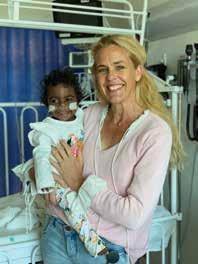
Next steps
► Following on from this study, the team were as successful in securing a $1.97 million Medical Research Future Fund grant to develop and trial an effective, culturally secure follow-up strategy, to ensure that Aboriginal children around the nation are receiving effective medical follow-up and treatment
► The four-year trial will be led by Telethon Kids Institute in collaboration with The University of Western Australia (UWA) and the Menzies School of Health Research, with a team of researchers from Telethon Kids, UWA, the Queensland University of Technology, the University of Queensland, and Curtin University
► The group will work with partner organisations from Queensland and from the Kimberley and Pilbara regions in Western Australia, including Aboriginal medical services that support remote-living First Nations communities
Did you know?
• Aboriginal children have the world’s highest reported rates of acute lower respiratory infections, experiencing higher hospitalisation rates and more severe disease than other Australian children
• Aboriginal children hospitalised with acute chest infections are at risk of developing bronchiectasispermanent life-shortening lung damage
• The earliest sign of chronic lung disease after hospitalisation is usually a wet cough for more than four weeks. If the ongoing wet cough is managed early, bronchiectasis can often be prevented
• Therefore, effective follow-up after being discharged from hospital is essential
This research was supported by a Perth Children’s Hospital Foundation (PCHF) New Investigator Grant, a WA Health Translation Network Medical Research Future Fund: Rapid Applied Research Translation Grant, and by Mineral Resources Limited, proudly supporting the Wal-yan Respiratory Research Centre via PCHF as Principal Partner of the BREATH (Building Respiratory Equity for Aboriginal and Torres Strait Islander Health) Team. The team is led by paediatric lung health researcher, and Mineral Resources Fellow, Professor André Schultz. DRCapital and INPEX also support Kulunga Kimberley
A public health campaign to raise awareness about the dangers of chronic wet cough in Aboriginal children is helping to improve detection, diagnosis and management of the condition.
Co-designed with the Aboriginal community and supported by actor Ernie Dingo and former West Coast Eagle Francis Watson, the campaign included the development of culturally sensitive materials including flip charts, posters, talking posters, banners, flyers, stickers and badges. It also raised awareness about chronic wet cough through in-person ‘yarning’.
A wet cough experienced by a child for more than four weeks can be a sign of underlying infection known as protracted bacterial bronchitis (PBB). If left untreated it can lead to permanent life-shortening lung damage known as bronchiectasis.
PBB is prevalent in Aboriginal children with recent studies identifying the condition in 10 per cent of Aboriginal preschool children in communities in WA’s West Kimberley.
To raise awareness of the dangers of PBB the BREATH team and Telethon Kids Institute’s Kulunga Aboriginal Unit partnered with Kimberley Aboriginal Medical Services, Yura Yungi Aboriginal Medical Services, Aboriginal families, and clinicians to develop and implement an intensive health promotion campaign.
The partnership aimed to raise awareness and develop solutions for timely detection, accurate diagnosis and optimal management of chronic wet cough in Aboriginal children – with the ultimate aim being to improve the lung health of Aboriginal kids.
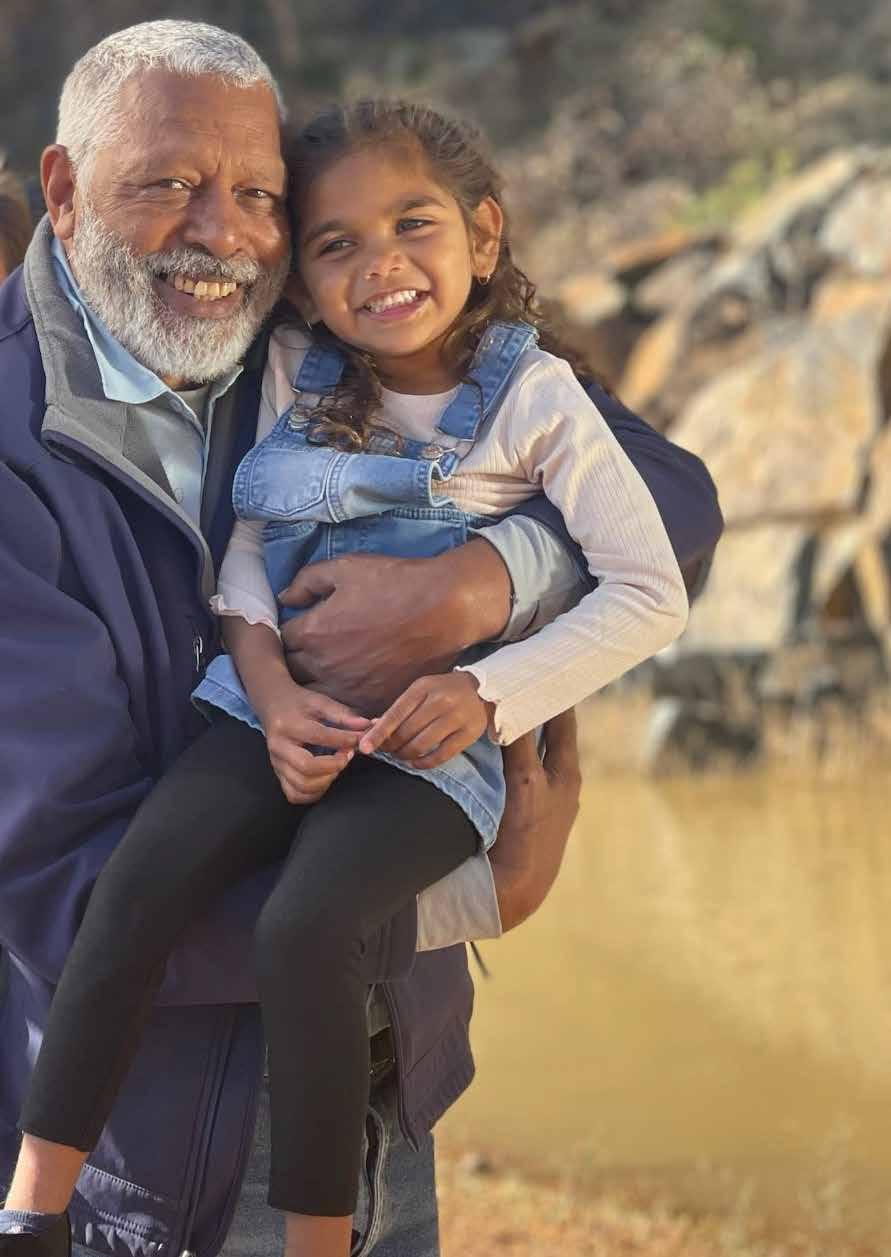
The health promotion campaign, which built on a successful wet cough prevention health campaign in Broome, was implemented in Halls Creek and the Balgo, Mulan and Billiluna communities in the Kutjungka region.
It also included health messages played on the region’s radio station and targeted social media advertisements.
The BREATH team aims to partner with other Aboriginal communities around Australia to roll out similar campaigns, each adjusted to be culturally meaningful and sustainable for the communities in which they are delivered. Currently, work is under way in Derbarl Yerrigan Health Service in Perth and sites in the Northern Territory and Queensland.
It is hoped the campaign, together with the implementation approach, can serve as a guide for raising awareness and improving management of chronic wet cough in Aboriginal children right across Australia.
Mineral Resources proudly supports the Wal-yan Respiratory Research Centre as Principal Partner of the BREATH (Building Respiratory Equity for Aboriginal and Torres Strait Islander Health) Team.
46 | TELETHON KIDS INSTITUTE
Campaign designed to improve the lung health of Aboriginal children
Right: Ernie Dingo and Xania Coppin-Thomas feature in the health campaign
IMPACT REPORT 2023 | 47
Dr Pam Laird with young patient Charmaine Kelly
IN THE PIPELINE

48 | TELETHON KIDS INSTITUTE IMPACT REPORT 2023 | 49
THIS RESEARCH IS IN THE PIPELINE TOWARDS TRANSLATION
Five-year-old Scarlett Wood
Early detection helps delay onset of diabetes
About 140,000 Australian children have type 1 diabetes (T1D), and an average of three children are diagnosed every day. These children need lifelong daily insulin treatment to stay alive.
But a world-first study led by Dr Aveni Haynes at Telethon Kids’ Rio Tinto Children’s Diabetes Centre, is helping to detect early changes in blood sugar levels that occur before very young children are diagnosed with T1D to find the right time to intervene with future treatments to delay or prevent the condition.
Dr Haynes, who heads up the diabetes epidemiology research, started the study in 2021. It is the first-time children under two years of age have being monitored using a small device called a continuous glucose monitor (CGM). The monitor picks up early changes in glucose patterns in children known to be at risk of developing T1D before they have any symptoms, which can start months to years before diagnosis.
Detecting these early changes is vital to help identify children at risk who could be eligible for interventions to delay or prevent the onset of T1D. It also allows time for families and children to learn more about T1D symptoms and when to seek help.
“Our work is looking at early changes in the pattern of blood glucose levels in very young children in detail as the CGM will show us what’s happening to these levels whilst they are going about their usual activities,” Dr Haynes said.
“We’re using continuous glucose monitors, which are about the size of a 20 or 50 cent coin, that the children wear either on the tummy or just above the upper hipbone. They have a tiny probe that sits just under the skin and measures the sugar levels every five minutes, continuously for up to 10 days.
“We can then look at these glucose measurements to see how the patterns change during the day and night and look for very early signs that their sugar patterns are beginning to look different to what you would expect in a healthy child of that age.
“It’s a new way of looking for changes in blood glucose levels over time whilst at home doing their usual routine, rather than needing to come in for a blood test, which is at a single time point, or having to be fasted beforehand.
“Once we find a child has two or more antibodies, we know the risk of developing T1D in the next 10-years is 70 per cent,” Dr Haynes said.
“Early monitoring and detection of diabetes in a child means they can be seen by doctors before becoming too sick and a management plan can be put in place for them straight away.”
Next steps
► Last year the US Food and Drug Administration in the US, approved the first drug, Teplizumab, that can delay onset of type 1 diabetes for people at risk of developing T1D
► In January 2023, a child in the US who was identified as having early changes in blood sugar levels was one of the first to try the Teplizumab therapy to delay the onset of T1D
► Dr Haynes will continue to identify and monitor Australian children at risk of developing T1D using CGM, a key to finding the right time and children eligible for future intervention to delay the condition, as the therapies become available in Australia
► In 2023 Dr Haynes won a Telethon Kids Illuminate award for her CGM Study. The funding will go towards extending her current study across Australia
The study has been funded by The Leona M. and Harry B. Helmsley Charitable Trust 20212023, the JDRF Postdoctoral Fellowship 2020-2023; a Raine Priming Grant 2020-2022; an APEG Research Grant 2019; a Diabetes Research WA Clinical Research Grant 2019 and a WCHF Research Project
Study offers brighter future for Alex
Even before he was born Alex Chatterton was already doing his bit to help find a cure for type 1 diabetes.
Alex’s mother Justine lives with the disease and knows all too well how allencompassing it can be to manage. When the opportunity came to sign up her children, Penny, six, and Alex, four, for diabetes research in utero, it was an obvious yes. That was the start of Alex’s diabetes research journey.
Now, the happy four-year-old is part of a world-first CGM study looking at changes in blood sugar patterns in very young children at risk of type 1 diabetes, in the hopes of finding the right to time to intervene with future treatments to delay or prevent the condition.
He is one of 68 participants in the Australiawide CGM study. Like Alex, 42 of the participants have T1D-specific multiple antibodies, meaning the immune process underlying the condition was under way.
The Perth-led study is monitoring children like Alex regularly, using a small device called a continuous glucose monitor (CGM) to pick up early changes in glucose patterns in the children known to be at risk of developing
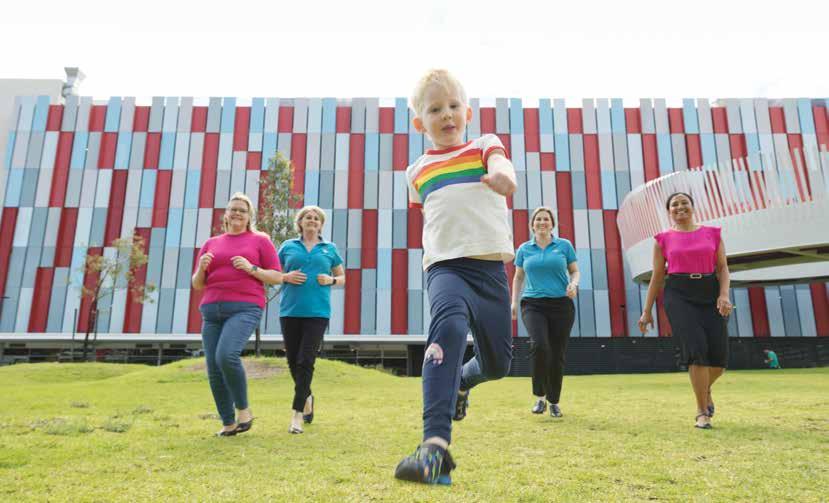
T1D, before they have any symptoms. These can start months to years before they would usually be diagnosed.
Justine said being part of the study had given them the knowledge that Alex was already multiple antibody positive, giving him a much higher risk of developing the condition.
“Being aware that Alex is multiple antibody positive has given us the warning that a diabetes diagnosis is most likely going to happen and it can prepare us for his management and prevent him needing major medical intervention at diagnosis.”
Did you know?
• Type 1 diabetes is a chronic autoimmune disease that results from the immune system attacking the insulinproducing cells of the pancreas
• Currently, type 1 diabetes cannot be prevented but it can be managed by administering insulin, monitoring glucose levels, having a healthy, balanced diet and getting regular physical activity
• In WA, about 160 children are diagnosed with diabetes every year
50 | TELETHON KIDS INSTITUTE
IMPACT REPORT 2023
Right: Alex Chatterton runs ahead of his (left to right) mum, Justine, clinical research nurses Alison Roberts and Alex Tully and Dr Aveni Haynes
Healing airways so kids with asthma can breathe better
An exciting study is investigating whether a new therapeutic treatment for asthma will protect young sufferers from ongoing lung damage and improve their long-term health outcomes.
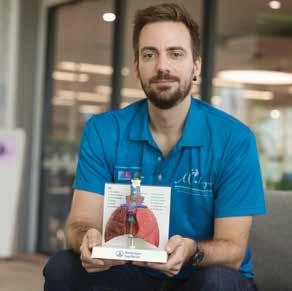
Researchers at the Wal-yan Respiratory Research Centre have discovered an Food and Drug Administration-approved medication traditionally used to treat pain in children and adults – that enhances repair and reduces inflammation in airway epithelial cells from children with asthma.
This discovery was led by Dr Thomas Iosifidis and his team whose research focuses on epithelial cells, which line the surface of the lungs.
“These cells form our lung’s first line of defence, providing a barrier against the outside environment, and are responsible for the initial responses to injury and infection such as viruses - one of the main triggers of asthma flare-ups,” Dr Iosifidis said.
These early responses to triggers have been under-studied because of the invasive nature of accessing airway tissue, particularly in children.
However, the team at the Wal-yan Respiratory Research Centre pioneered access to these airway samples and shown that the airway lining of children with asthma has abnormal responses to injury, is inherently “leaky” and inflamed, contributing to ongoing and worsening breathing problems.

Most importantly, the data suggest that the treatment strategy we’ve discovered may not only heal damaged airways, but also reduce the recurrence and severity of asthma flareups in children,” Dr Iosifidis said.
The research team, including collaborators at the University of Newcastle, was granted a patent in 2022 on the ‘Promotion of Epithelial Repair’, potentially paving the way for a new class of drugs which target a previously unknown asthma pathway.
“Our team, together with collaborators nationally and internationally, is now investigating the preclinical safety and effectiveness of these therapeutics, prior to clinical trial assessment,” Dr Iosifidis said.
“In the near future, our treatment solution will be able to help heal the airways of children with asthma, protecting them from ongoing damage and improving their long-term health outcomes.”
The Wal-yan Respiratory Research Centre is a powerhouse partnership between the Telethon Kids Institute, Perth Children’s Hospital Foundation and Perth Children’s Hospital.
This study is supported by funding from the National Health and Medical Research Council and a Telethon - BHP Blue Sky Award, and carried out in collaboration with the University of Newcastle
New treatments needed
Asthma remains a significant global healthcare burden, with more than 330 million sufferers worldwide. Young children are arguably the most disproportionally affected by asthma. In fact, asthma is the most common lifelong breathing disorder in children, with one in six Australian children experiencing asthma.
Despite use of current treatments, asthma remains one of the main causes of hospitalisation in children, resulting in time lost from school and work for parents and carers of children with asthma. Children with ongoing asthma also remain at the highest risk of lifelong respiratory diseases like severe chronic obstructive pulmonary disease.
Although there are ways to treat asthma symptoms, there is a pressing need for new treatments that focus on the root causes of asthma in early life so long-term health outcomes can be improved.
Next steps
► Future studies will aim to make safe and effective compounds that could be delivered through an inhaler to achieve maximal therapeutic benefit in the airways. These studies will take place in patient-derived cell cultures and appropriate animal models
► Following this, the team aims to perform its first proof-of-concept clinical trial in wheezy children
► Alongside this work, the team is exploring biomarkers to predict which children are at risk of persistent asthma symptoms in early life and could benefit from these treatments
52 | TELETHON KIDS INSTITUTE
IMPACT REPORT 2023 53
Tom Iosifidis
New life breathed into ground-breaking Aboriginal child health survey
In 1998, Telethon Kids Institute embarked on one of the most ambitious population health projects in Western Australian history – a sweeping survey of Aboriginal children and their families spanning the length and breadth of the State.
More than 25 years on, the data gathered by the ground-breaking Western Australian Aboriginal Child Health Survey (WAACHS) will form the basis of exciting new research and could prove more valuable than ever in Closing the Gap.
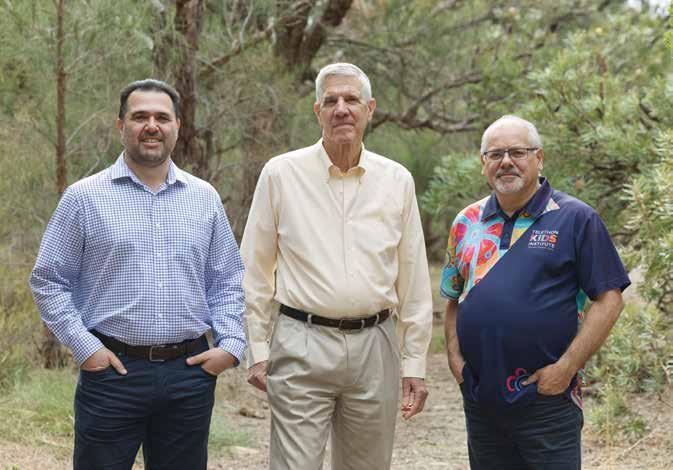
Professor Steve Zubrick can vividly recall the reaction when his team first proposed a large-scale health and wellbeing survey of Aboriginal children in WA.
“There was enormous scepticism – nothing had been done like this anywhere in Australia,” Professor Zubrick said.
“But there was a huge appetite from the WA Indigenous community to have high-quality population data that could give an insight into how their children were growing up.”
The WAACHS was the largest and most comprehensive study ever undertaken into the health and wellbeing of Aboriginal and Torres Strait Islander children.
Some 5,289 Aboriginal children and their families were interviewed, with the survey reaching into the most remote corners of the State. Its findings were so detailed, they had to be published across four weighty volumes.
WAACHS laid bare for the first time the true extent of social and economic disadvantage faced by many Aboriginal children and the role this played in the disturbing gap in life expectancy between Indigenous and nonIndigenous Australians.
It exposed the deep scars of intergenerational trauma caused by successive government policies – but it also shone a light on remarkable resilience, bolstered by strong family and community bonds, and a burning desire to keep families together and help children grow up strong.
Revisiting data for more positive change
A quarter of a century later, it’s hoped the power of those reports will again light the spark for change.
Associate Professor Francis Mitrou, who worked on the ‘90s iteration of WAACHS, will lead a new Federally-funded project to revisit the survey data.
The project team will be able to link the information gathered decades ago with data held by a whole range of Government agencies stretching back more than 40 years.
“We know that those early years are really crucial to the development of children –physically, cognitively and emotionally,” Associate Professor Mitrou said.
“We are in a unique position to pinpoint the areas that need the most focus and where policy changes could make a positive impact and improve Closing the Gap indicators.
“We’ll be able to look through multiple lenses – health, education, child protection, and justice – over long periods of time to work out what’s working and what’s not working for Aboriginal children.
“We will do this work under the guidance and direction of strong Aboriginal governance and in partnership with Aboriginal communities.”
Next chapter for major study
Telethon Kids Institute’s Director of First Nations Strategy and Leadership and Noongar man, Associate Professor Glenn Pearson, was a project officer on the original WAACHS study.
He said carrying the work forward would give significant insights into whether much had changed.
“One of the things that stood out for me in the initial project was the toxic level of stress that sits on top of Aboriginal families,” Associate Professor Pearson said. “We asked the families about what we called ‘life stress events’ in the survey – things like a death in the family, financial problems or family conflict.
“We all know we’re under the pump, but when you compare what’s happening in mainstream Australia to the levels of stress faced by Aboriginal people on a daily basis –that was pretty powerful.”
The evidence gathered through the WAACHS study about the mental health burden on Aboriginal families formed the basis of ongoing work in the youth mental health space at Telethon Kids.
Associate Professor Pearson said linking the data breathed new life into the rich and valuable findings of the survey.
“This allows us to go back to the community and connect those dots, because fundamentally – this is their story.”
This project was funded by a Synergy Grant from the National Health and Medical Research Council
54 | TELETHON KIDS INSTITUTE IMPACT REPORT 2023 | 55
Associate Professor Mitrou, Professor Steve Zubrick and Associate Professor Glenn Pearson
Journey Together for a better future for Aboriginal Kids
The saying goes that there’s a solution for every complex problem: simple, quick and wrong.
Aboriginal families and communities have endured the imposition of countless ‘solutions’ and had to live with the consequences of these ineffective initiatives. Those consequence are sadly evident in the unrelenting gap in outcomes for Aboriginal kids, compared with other Australian children.
To enable change, we have to do things differently.
That’s the essence of the Journey Together Initiative, an ambitious five-year research collaboration that sets out to unpack the complexity of how we – our systems and services – have to transform to better respond to the needs of Aboriginal families to grow up healthy kids.
Supported by BHP through generous funding to Telethon, at its core is a firm commitment to Aboriginal leadership, culture and community.
It’s an important difference.
Leading the science is the Institute’s Professor Alex Brown, an internationally recognised Aboriginal clinician and researcher.
“This is a long way from your traditional research approach, and that’s why we will get different answers,” Professor Brown said.
“In Journey Together we’ve worked with community and services to understand their priorities, support programs that respond
Cultural leadership a guiding light
The Pilbara is a land of extremes.
The region’s vast resource wealth is the backbone of our nation’s economy, but Aboriginal children living in the Pilbara face significant health and wellbeing challenges driven by dispossession, poverty and remoteness.

to those needs, and embed our research mechanisms into those programs – usually it’s the other way round.”
The Journey Together Initiative has reached a major milestone with priority projects led by Aboriginal community-controlled organisations under way in all three sites –Port Hedland, Newman and Perth.
In Port Hedland, the Kumaparniku Wraparound Service through Julyardi Aboriginal Corporation is supporting young families with very high needs, many of whom have experienced high levels of trauma.
Puntukurnu Aboriginal Medical Service in Newman is running a project focused on perinatal and early child development, with better support in pregnancy and early life.
In Perth, Derbarl Yerrigan Health Service is developing a new paediatric and child development model of clinical care that takes a holistic, family-centred approach embedded in primary healthcare.
In development are projects with Wirraka Maya Health Services that will focus on teens and mental health, and with Moort Dandjoo Kaadajini’s Early Learning Program.
By the end of 2023, a targeted round of comprehensive social, cultural and medical needs assessments will be under way.
Add to this the updating and relinking of the ground-breaking WA Aboriginal Child Health Survey and you have an unprecedented depth of data.
“It’s the triangulation of all these varied experiences, environments and data that will provide a new level of understanding and the opportunity to co-design tailored responses according to need and context,” Professor Brown said.
That’s what has the Institute’s Director of First Nations Strategy and Leadership, Associate Professor Glenn Pearson, really excited.
“Every child, every family, every community has its strengths and challenges. Journey Together is not about a one-size-fits-all solution, but a deep understanding of the elements of what it takes for Aboriginal kids and families to thrive. That’s powerful for community, for services and policy makers,” Associate Professor Pearson said.
“These community-led projects are responding right now to community priorities and that has real value. By pulling all the different threads together, we will get insights at a whole new level, and I can’t wait to see where this journey takes us.”
It’s an everyday challenge that deeply troubles the Elders on the Hedland Aboriginal Strong Leaders group (HASL), which provides cultural advice and guidance to the vital work of Journey Together in Port Hedland.
It was their leadership that led to the establishment of the Kumaparinku Service, the priority project run by Julyardi Aboriginal Corporation that delivers wraparound support to families that are most in need.
“The word Kumaparinku means we’re all coming together as one, supporting and looking after our children,” Kariyarra Elder and Co-Chair of HASL, Raylene Button said.
“We want to be able to leave behind strong families, teach them parenting skills, teach them to keep their kids safe and get a better understanding of what we need to grow our kids and give them a better future.”
Ngarluma Elder and Vice Co-Chair of HASL, Maureen (MK) Kelly OAM JP, said a lack of secure housing and access to healthcare affected many local families.
“We know that if you don’t assess and address medical issues with children, they fail to thrive in life and they just become another statistic,” she said.
“We were keen for this research to happen so we can collate all the evidence and use that to get what’s needed. We know just by looking at children that they need help and things need to change.”
IMPACT REPORT 2023 57
Journey Together is supported by BHP through generous funding to Telethon.
Pre-surgery fasting tablet helping to keep kids comfortable
Preparing a baby or young child for surgery can be stressful for parents and hospital staff.
Often, the child will need to fast before their procedure for safety reasons, which means very young children and babies can be uncomfortable, irritable and generally unhappy ahead of their operation.
Sometimes the hunger can even lead to vomiting, which can cause dangerous dehydration ahead of surgery.
It’s a common problem faced by researchers in Telethon Kids Institute’s Perioperative Medicine Team – many of whom are also anaesthetists at Perth Children’s Hospital.
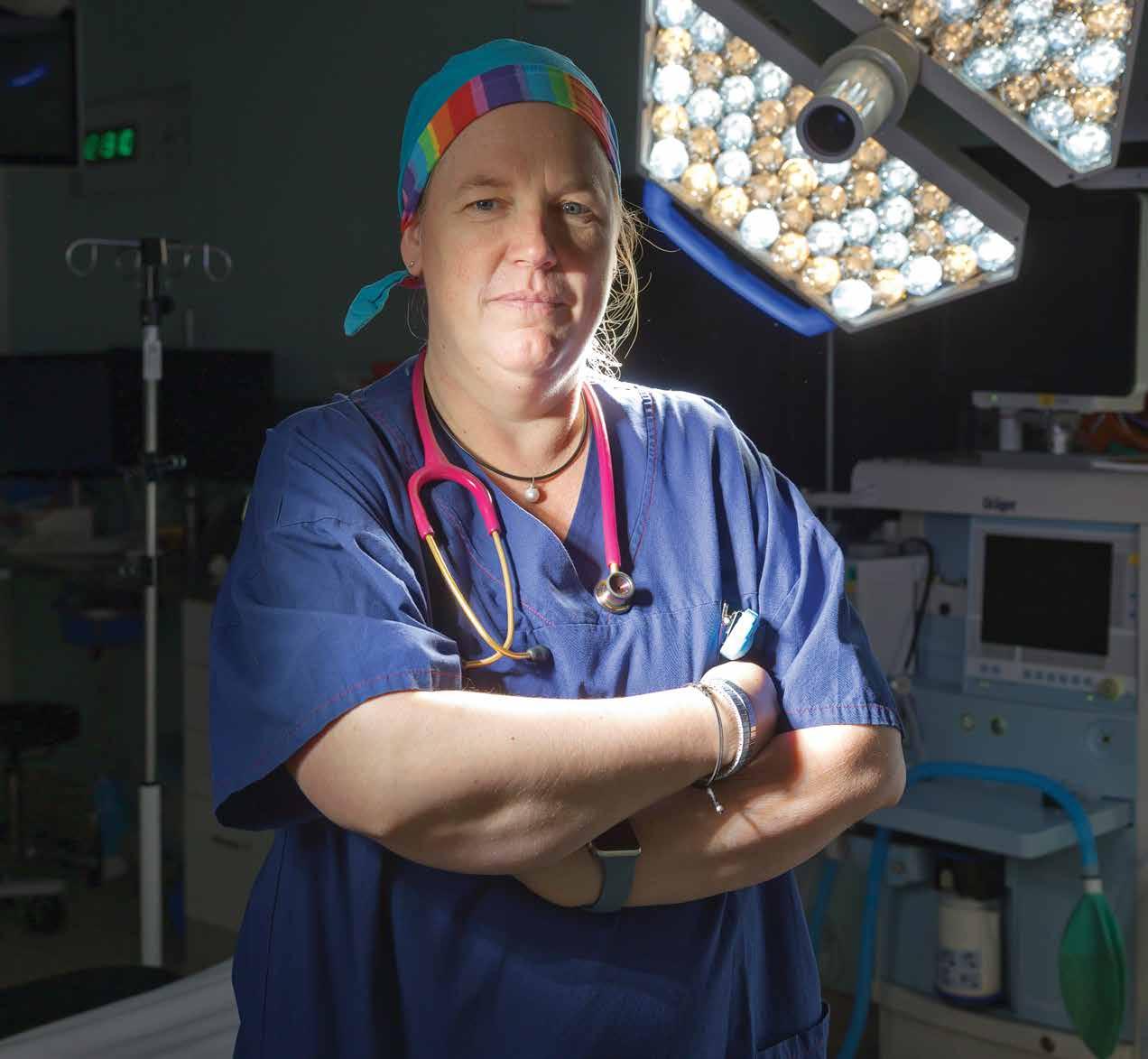
In collaboration with scientists from The University of Western Australia (UWA), the team – led by Co-program head of Perioperative Care, Professor Britta Regli-von Ungern Sternberg – has developed a unique chewable tablet that gives the child the sensation of having a full stomach, without compromising their fasting regime.
Associate Professor David Sommerfield, from the Perioperative Medicine Team, Perth Children’s Hospital and UWA, said the tablet was pleasant-tasting and designed to reduce pre-operative stress in young children.
“Our product is designed to not interfere with fasting guidelines in children while providing them with a comforting sensation of having consumed solid food,” Associate Professor Sommerfield said.
“Allowing fasting patients to eat these chewable tablets will help to relieve hunger and distress. An added advantage of this new product is that it does not have to be consumed with water.”
Natural relief for pain
Telethon Kids Institute’s Perioperative Medicine Team was recognised in 2022 for its outstanding commitment to consumer engagement in its research.
The team’s collaborative and wide-spread consultation for the ‘Bee Pain Free’ study, which evaluated the use of honey as a natural pain management treatment option for children who have had their tonsils removed, was awarded runner up in the Australian Clinical Trials Alliance Consumer Engagement Prize.
Professor Britta Regli-von Ungern Sternberg said the trial, which involved 400 children who had a tonsillectomy in WA, was undertaken following feedback from parents that they were keen to have alternatives to strong pain relief medications.
“The burden of pain management was falling on parents, and they were wishing for non-traditional alternatives,” she said.
Associate Professor Sommerfield will now lead a pre-clinical trial to further develop the fasting tablet.
“The pre-clinical trial will allow us to assess the taste acceptability of the fasting tablets to children and to assess with medical staff the appropriateness of the pre-procedural tablets,” he said.
“In the future, these tablets will be tested in a clinical trial in a real-life setting with children fasting before surgery.”
This research has been made possible thanks to the Channel 7 Telethon Trust
“We knew that honey has been a valued medication since ancient Egypt, known for its anti-inflammatory, analgesic and antioxidant properties, and we thought it would be a good topical treatment for children.”
IMPACT REPORT 2023 | 59
Left: Professor Britta Regli-von Ungern-Sternberg, co-head of the Perioperative Medicine Team at Telethon Kids
58 |
Researchers call for rethink on infant screentime
A Telethon Kids Institute study has found the average six-month-old Australian baby has more than one hour of screen time each day. The Australian Government and World Health Organization recommend zero screen time for kids under the age of two.

But is it time to rethink that recommendation for the digital age, and is there space for a more nuanced conversation about how to have ‘quality’ screentime with your child?
Study manager in the Early Years Systems Evidence team at Telethon Kids Institute in Adelaide, Mary Brushe, believes parents can use screentime as an opportunity to grow their child’s language development and social and emotional learning.
“What we really want families to focus on is the question of whether their child is having quality screentime, and to keep interacting with their child while they’re watching,” Ms Brushe said.
“Instead of not talking while a screen is on, parents could ask their child questions or narrate what they are seeing together, even if the child is too young to respond.”
Ms Brushe led a study that placed wearable devices similar to a fitness tracker on the wrists of hundreds of babies to constantly record parents speaking to their child during the first four years of life, and measure what impact that had on the child’s language development.
The study team was then able to differentiate between spoken language and ‘electronic noise’ picked up by the device. From there they could distil how much screen time the child was exposed to on an average day.
“Some of that might include when a TV’s been left on in the background around a child or when the parent is watching something on a phone close to the child,” Ms Brushe said.
“Even though we might think the TV is just on in the background, often the child will still be paying attention to it and is often drawn by the bright colours and sounds.”
The study team found some children in every age group under two were being exposed to more than six hours a day of screentime.
Ms Brushe said the idea that a child in 2023 would have zero screentime before the age of two was unrealistic and would likely add unnecessary guilt and pressure to families.
Her team is now leading a Telethon-funded project to develop a suite of resources to help Australian families better manage their young child’s screentime and make sure they’re reaping the potential benefits of positive screentime.
This research was made possible by the generous support of the Channel 7 Telethon Trust
Did you know?
• The average sixmonth- old in Australia is spending more than an hour a day in front of a screen
• Some children were found to be having up to six hours of screentime per day
• 221 families across Australia took part in the study
60 | TELETHON KIDS INSTITUTE
IMPACT REPORT 2023 61
Right: 15-monthold Annie Price watching an iPad
We thank all our generous supporters - all of the individuals, corporates, trusts and foundations - who help deliver and drive our research impact so we can continue to make a difference for children, young people, families and communities. We simply could not do it without you.
Our Principal Partner, Telethon, continues to achieve remarkable levels of community engagement and support, and we are humbled to be one of their beneficiaries, and proud to wear the Telethon name as a reflection of the enormous support we have received over so many years.
Read more about the philanthropy that supports our work in our Annual Report: telethonkids.org.au
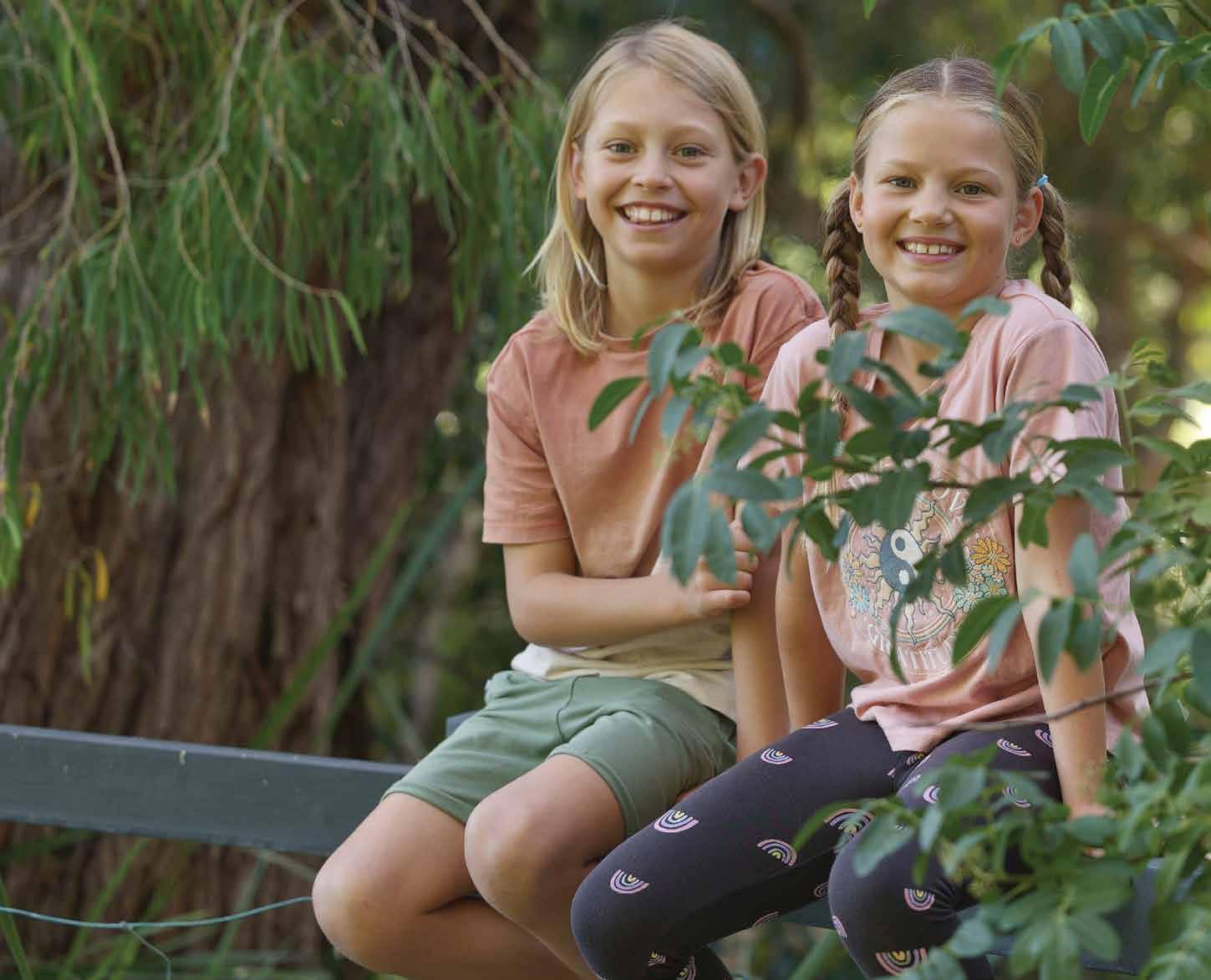
For further information about donating to the Telethon Kids Institute, subscribing to our mailing list or joining us for a tour of our facilities, please contact us on:
T | 08 6319 1000
E | contact@telethonkids.org.au
W | telethonkids.org.au
62 | TELETHON KIDS INSTITUTE
Nine-year-old Griffin Sharp (left) with his sister Rosie Sharp, 7
Northern Entrance, Perth Children’s Hospital, 15 Hospital Avenue, Nedlands WA 6009 PO Box 855, West Perth Western Australia 6872
T | 08 6319 1000
E | contact@telethonkids.org.au
W | telethonkids.org.au
PRINCIPAL PARTNER










































